

Together We Roam
Step into a world where you can roam freely with the largest land animals on Earth. Experience what it feels like to coexist with them. To become one with the herd. To be more than just a passive witness to these incredible creatures.
Here, you'll walk beside them. Together, on common ground. Because it takes standing by them for you to truly be inspired to stand with them. And become a part of a movement that helps protect them for generations to come.
This is Elephant Valley. A space that will bring us together like never before. A place where together, we roam .
Introducing Denny Sanford Elephant Valley at the San Diego Zoo Safari Park

Bringing The Savanna To You
Your expedition through Elephant Valley at the Safari Park will take you into the heart of the savanna. With vistas on both sides of the pathway, the sights and sounds of the African grasslands will come alive, transporting you to a place where your family and our elephant family become one.

Sign Up For Elephant Valley Updates And More
Please leave this field empty
Your generosity will transform Elephant Valley and the future of elephant conservation worldwide. To donate or for questions about this project, click below or contact the Philanthropy team at 619-685-3219 or [email protected] .

- Give Monthly
- San Diego Zoo
- Safari Park
- Special Experiences
- Plan Your Visit
- Renew/Rejoin
- Conservation
- Take Action
- Adventure Travel

News Release
FOR IMMEDIATE RELEASE CONTACT: San Diego Zoo Wildlife Alliance Public Relations 619-685-3291 [email protected] sdzwa.org
NEWS RELEASE
San Diego Zoo Safari Park Announces Elephant Valley, Largest Transformative Project in 50-year History
Wildlife Conservation Leader Will Bring Guests Closer to Elephants Through New Immersive Experience
SAN DIEGO (Aug. 10, 2023) – San Diego Zoo Wildlife Alliance has announced construction is officially underway on the largest and most transformative project in the San Diego Zoo Safari Park’s 50-year history. The all-new Denny Sanford Elephant Valley will reimagine the heart of the Safari Park, turning the current elephant environment into a dynamic savanna and a place of exploration. Elephant Valley will give guests of all ages the opportunity to connect with elephants like never before, encouraging greater empathy, understanding, and appreciation of this majestic species—and igniting a passion for wildlife.
“We are thrilled to announce Denny Sanford Elephant Valley—a first-of-its-kind immersive experience for visitors, to further connect the vital work happening here in San Diego to the collaborative elephant conservation initiatives we support in the field,” said Paul A. Baribault, president and chief executive officer, San Diego Zoo Wildlife Alliance. “Elephant Valley could not be achieved without the incredible community, donors, members and allies who support us and make all our conservation work possible with partners around the world.”
Surrounded by elephants on multiple sides, including from below via an overhead walkway with views of the herd passing through, guests will learn about the crucial role elephants have as ecosystem engineers, and about their intricate social dynamics. Elephant Valley will provide guests with new insight into the role San Diego Zoo Wildlife Alliance pursues as a leader in wildlife conservation. It will highlight the organization’s world-changing partners and celebrate the vibrant cultures and local communities where people and elephants coexist.
At the center of the guest experience in Elephant Valley is a two-story lodge, inspired by the destinations frequented by travelers while on safari in Africa. This gathering place will provide opportunities to learn from educators about the awe-inspiring wildlife of the region, while witnessing elephants wade in expansive watering holes. The rich plant life in Elephant Valley has been carefully curated by a team of expert horticulturists and arborists to authentically reflect the sights, sounds and smells of the African grasslands. The vast new habitat will provide enhanced experiences for the herd of elephants by introducing several innovative features that align with seasonal variations to closely replicate the African savanna year-round.
“As magnificent as elephants are, their future is equally fragile,” said Lisa Peterson, executive director, San Diego Zoo Safari Park. “We are honored to take millions of wildlife allies on a journey into the life of elephants, where they will learn about the positive impact everyone can have, and share in our hope for elephants worldwide. Elephant Valley will be a place where curiosity turns into discovery—where anyone from ages 1 to 100 will experience breathtaking moments of wonder in nature. Our hope is that the defining memories you make here stay with you for a lifetime.”
The effects of climate change, challenges to human-wildlife coexistence, habitat loss and poaching are taking a toll on elephant populations. African savanna elephants are currently listed as Endangered on the International Union for Conservation of Nature Red List of Threatened Species. Conserving African elephants has long been a top priority for San Diego Zoo Wildlife Alliance. Working closely with Save the Elephants, The Nature Conservancy, Northern Rangelands Trust, Kenya Wildlife Service and Reteti Elephant Sanctuary in Kenya. Scientific studies conducted in both Africa and with the elephant herds at the San Diego Zoo and Safari Park, provide a unique opportunity to increase the understanding of the species, and help develop additional conservation solutions. Increasing knowledge of the complexity of elephant social behaviors and the understanding of their overall health needs has given San Diego Zoo Wildlife Alliance and its partners valuable insight into what successful conservation outcomes look like for elephants.
“Elephants across Africa are facing immense challenges, which require all of us to collaborate and find sustainable conservation solutions for elephants and people,” explained Nadine Lamberski, DVM, chief conservation and wildlife health officer, San Diego Zoo Wildlife Alliance. “We are eager to witness the impact Elephant Valley will have on our continued elephant conservation efforts globally.”
Elephant Valley is funded by thousands of generous donors and longtime San Diego Zoo Wildlife Alliance supporter Denny Sanford. In addition to Elephant Valley, Sanford was the lead donor for Wildlife Explorers Basecamp at the San Diego Zoo, and for the educational television programing of San Diego Zoo Wildlife Explorers, provided at hundreds of children’s hospitals, Ronald McDonald Houses and other facilities across the globe. Elephant Valley is expected to be completed in 2025. For more information and to make a donation, visit sdzsafaripark.org/elephantvalley .
About San Diego Zoo Wildlife Alliance San Diego Zoo Wildlife Alliance, a nonprofit conservation leader, inspires passion for nature and collaboration for a healthier world. The Alliance supports innovative conservation science through global partnerships. Through wildlife care, science expertise and collaboration, more than 44 endangered species have been reintroduced to native habitats. Annually, the Alliance reaches over 1 billion people, in person at the San Diego Zoo and San Diego Zoo Safari Park, and virtually in 150 countries through media channels, including San Diego Zoo Wildlife Explorers television programming in children’s hospitals in 13 countries. Wildlife Allies—members, donors and guests—make success possible.
Link includes:
- Artist renderings of Elephant Valley
- Photos and B-roll of the Safari Park herd of African elephants
- San Diego Zoo Tickets
- Safari Park Tickets
The elephants of Africa: a complete guide to the best places to see them in the wild
Jul 28, 2022 • 7 min read
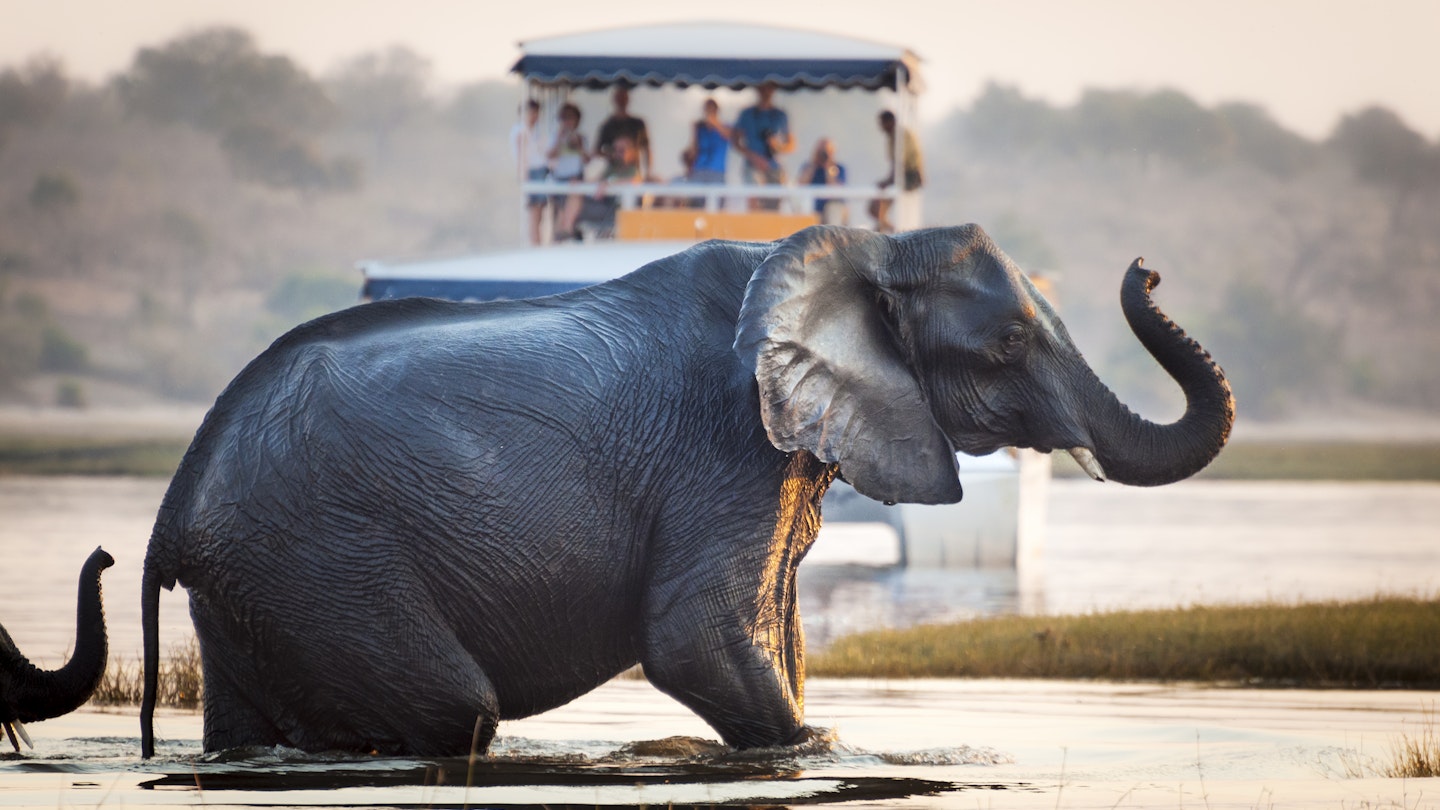
On the lookout for elephants; Chobe National Park in Botswana, Africa © Getty Images / iStockphoto
The African elephant is a gentle giant, not to mention the earth’s largest land mammal and perhaps the most enduring symbol of nature’s grace and fragility.
While elephants are a common sight when safariing in Africa , they are also facing unprecedented threats to their existence. The imperative to understand more about them and experience them in the wild has never been stronger. In this guide, we help you to do both.

African elephants: the behemoths (and the hunted)
An adult African elephant is seriously large. A fully-grown male can weigh in at a massive 13,334lb (6048kg); even the smallest adult male rarely dips below 8820lb (4000kg), which is two-and-a-half times heavier than your average family car. Females are usually just over half the weight of the male. The size difference between the two is not quite as pronounced when it comes to height – the tallest males are 13ft (4m) tall, the tallest female rises to 11ft (3.4m). Apart from overall size, and unless the male is aroused, the most obvious difference between males and females is that females have an angular forehead, while a bull’s forehead is more rounded.
An elephant has the largest brain of any mammal; it can weigh up to 13lb (6kg). Its trunk, which serves an elephant like a hand, can be 6.6ft (2m) long and weigh over 287lb (130kg) – a trunk has no bones but may have 60,000 muscles in it. An elephant uses its tusks as both tools and weapons. The longest recorded tusks were 10ft (3m) long, while the heaviest reached 154lb (70kg).
Apart from humankind, elephants have few natural enemies. In some areas, such as Hwange National Park in Zimbabwe or, in the 1980s, in the Savuti region of northern Botswana , certain lion prides have learned to hunt infant and adolescent elephants.
If left alone, elephants can live to between 55 and 70 years old.
Where to go on your first safari in Africa
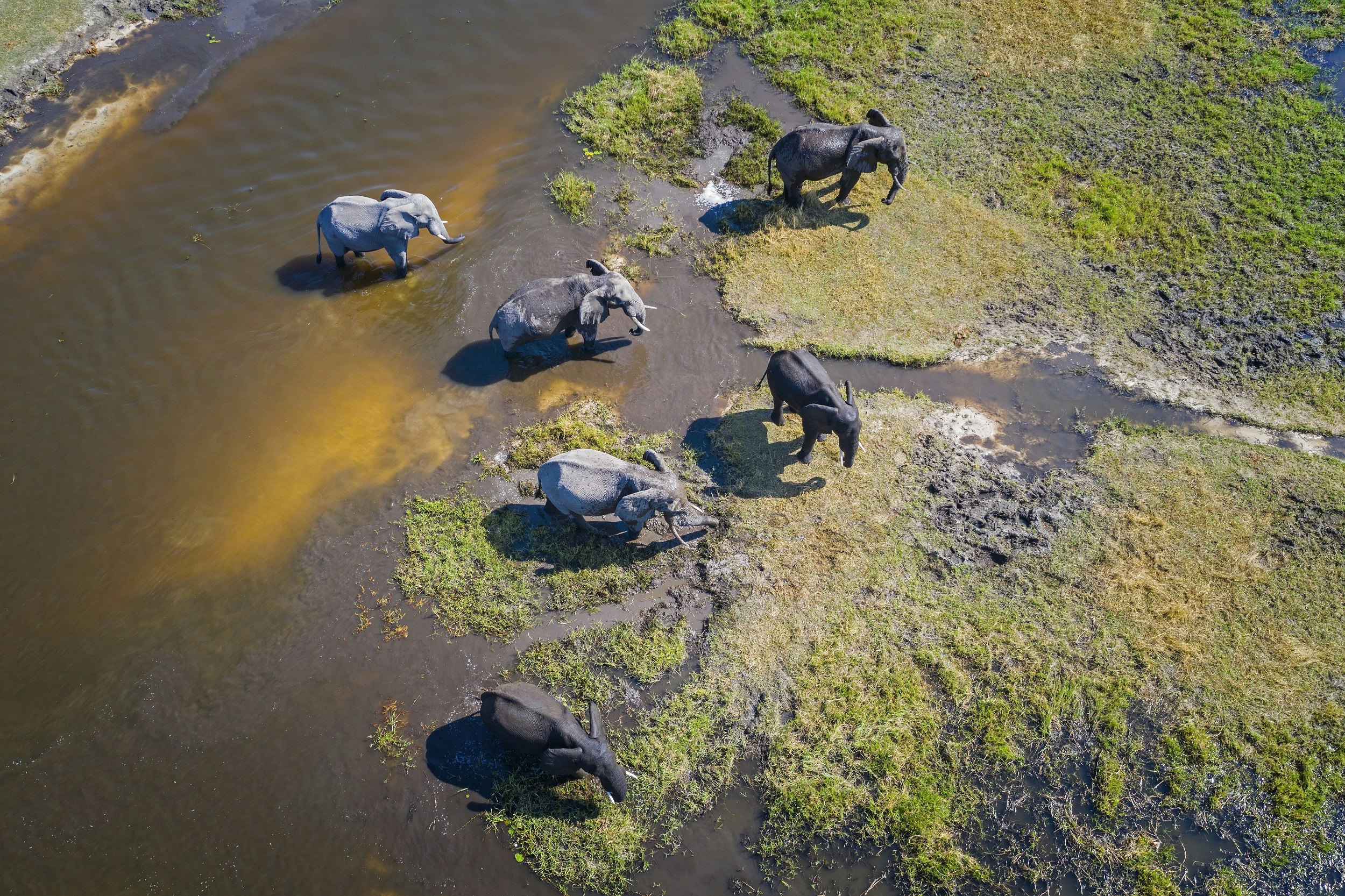
The elephant sisterhood
Elephants live in a close, cross-generational sisterhood of females. An elephant mother has one of the longest pregnancy periods in the natural world: around 650 days. Most often, the mother gives birth to a single calf, and that calf will be able to walk, albeit unsteadily, within hours of being born. Baby elephants continue to breastfeed throughout the first two years of their lives, and many will not be truly independent until the age of ten. If the young elephant is a male, he will leave the herd of its birth somewhere between 10 and 14 years of age. Sometimes this dispersing male will remain alone or attach itself to an experienced larger bull elephant. Young female elephants remain with their natal herd, which may consist of their mother, grandmother, aunties, female cousins and other related females. This female bond will last throughout a female elephant’s lifetime. The herd is usually led by an older matriarch, an experienced female that takes the herd to water in times of drought and is the first to stand in defense of the herd’s members.
Top tips to make your African safari more affordable
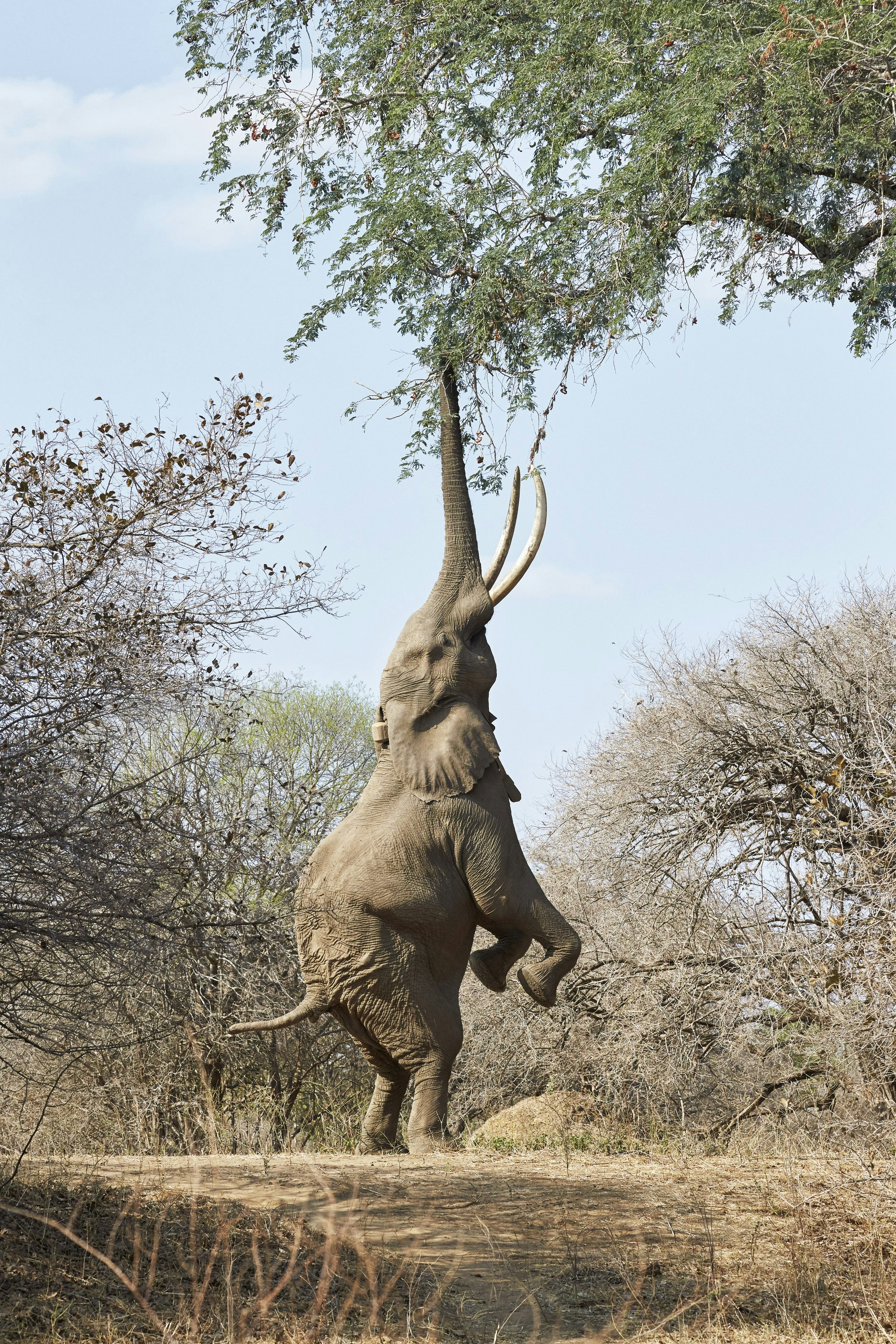
The world's most voracious vegetarians
Elephants are strict vegetarians and eat grass, leaves, fruits and even branches or twigs. In any 24-hour period, elephants will spend up to 19 hours eating and can eat up to 750lb (340kg), or around 5% of their not-inconsiderable body weight. If you extrapolate those figures further, elephants consume around 50 tons of food every year. At the other end, elephants defecate up to 30 times a day and deposit as much as 330lb (150kg) of dung in the process. Elephant dung serves a critical ecological purpose, spreading undigested seeds (a food source for insects, baboons and birds) which enable trees to spread their progeny; one study found that a single piece of elephant dung contained nearly 5700 acacia seeds.
Safari animals: the story of lions (and the best places to see them)
Elephants drink between 26 to 52 gallons of water per day. This compensates for the fact that as much as a gallon is lost every hour through the process of transepidermal water loss (through the skin), and that they urinate up to 13 gallons each day.
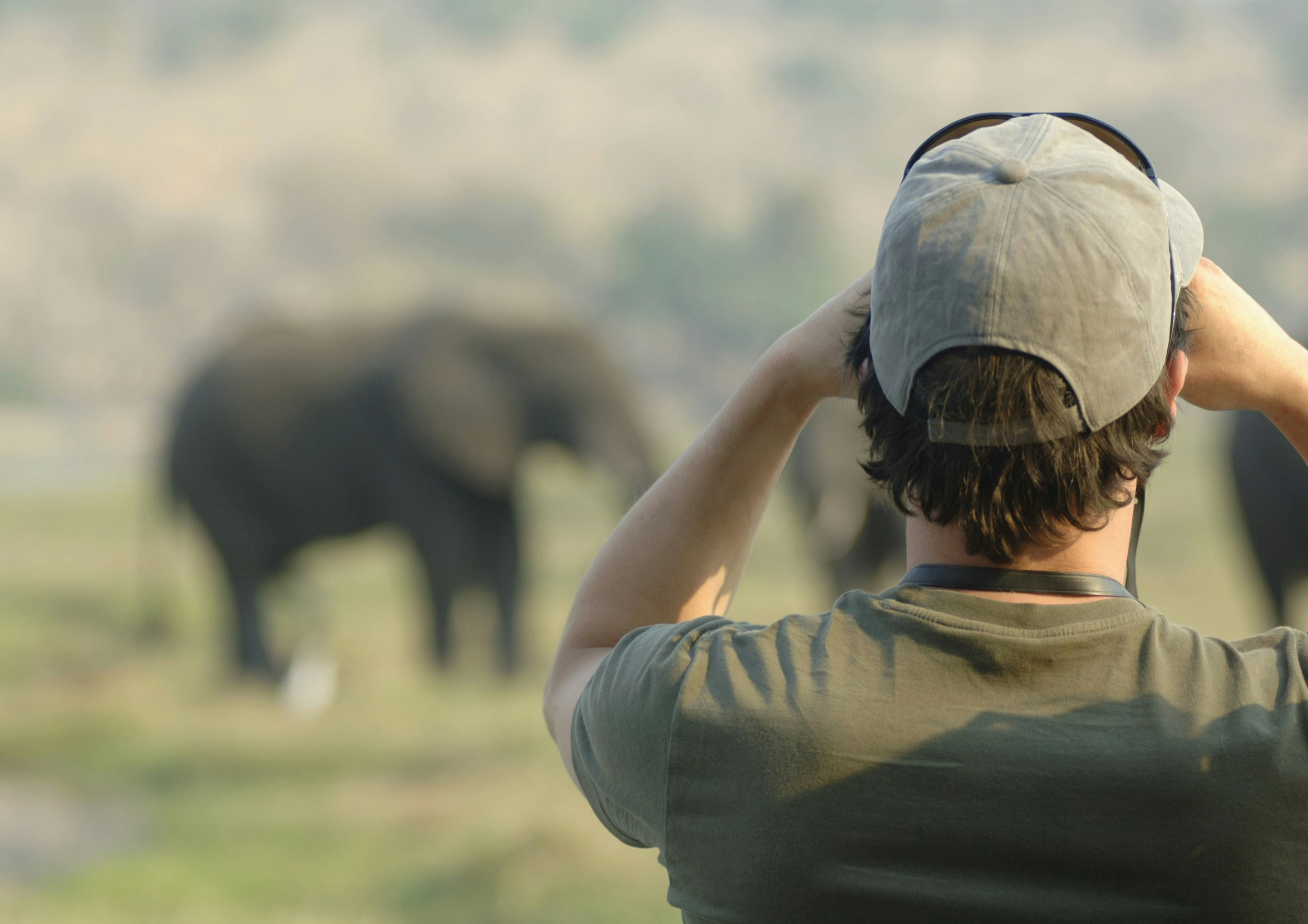
The best places to see elephants on safari
There are two species of African elephants: the forest elephant and the bush elephant. The much larger bush elephant is most commonly found in the savanna and light woodlands of East Africa and Southern Africa , with smaller populations in West Africa . The forest elephant is predominantly found in the forests of Central Africa, although their ranges do sometimes spill over into East and West Africa.
The 2016 Great Elephant Census – the most comprehensive survey of elephants ever undertaken – counted 352,271 African bush or savanna elephants spread across 18 countries.
Elsewhere, the Asian elephant, which is considerably smaller than the African elephant, is now restricted to isolated populations throughout the Indian Subcontinent and South-East Asia.
A day on safari in Africa: what you can expect in camp and in the wild
Botswana has more elephants than any other country, more than 130,000 in 2016. Anywhere in the Okavango Delta can be outstanding, but Chobe National Park is one of the best places in Africa to see elephants, with big elephants in big herds.
Kenya has some of the best elephant watching on the continent. The best is Amboseli National Park , but the Masai Mara , Tsavo East and Tsavo West national parks, as well as the Samburu National Reserve are excellent as well.
Safari without the big bucks
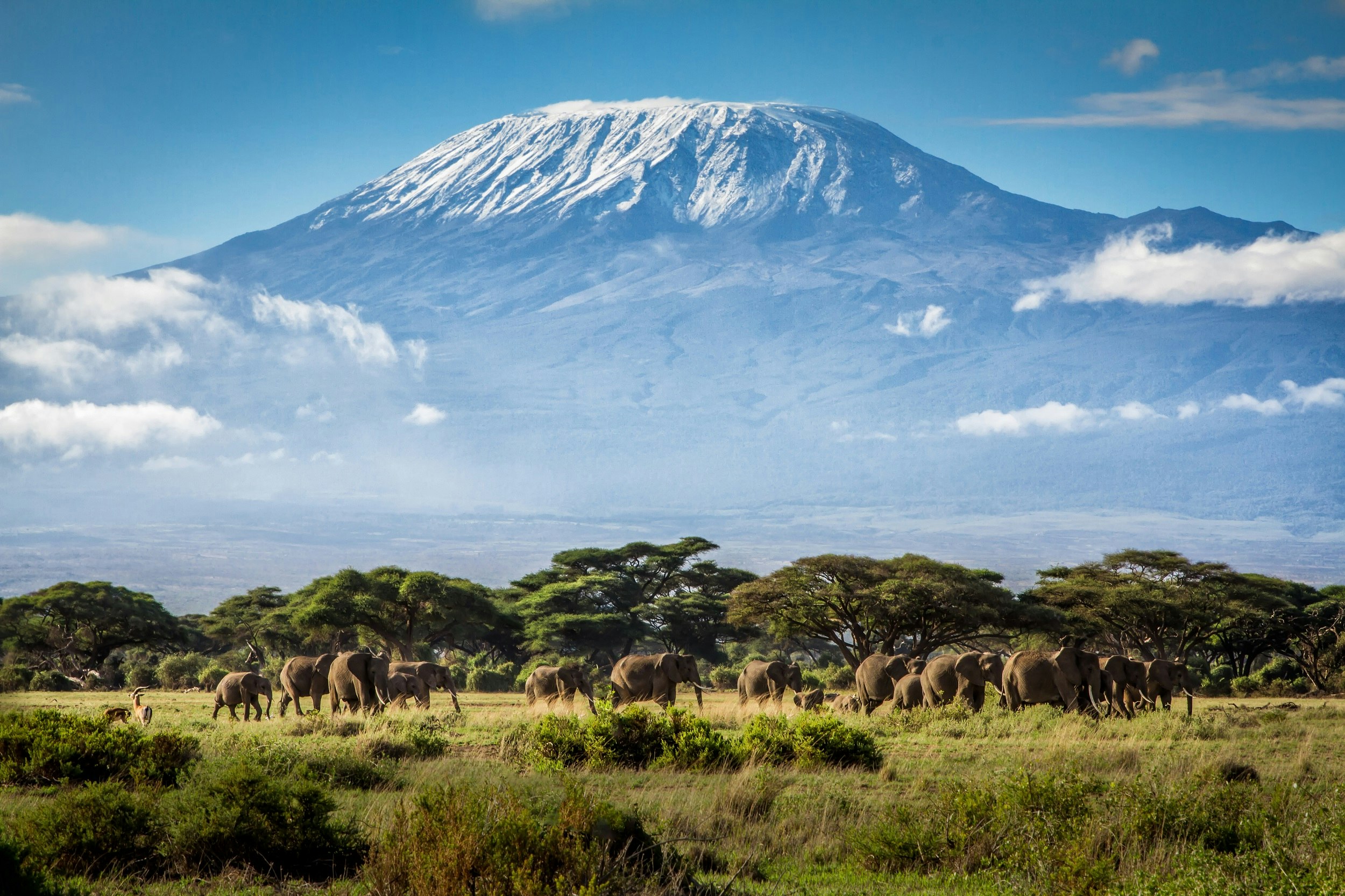
South Africa
As always for wildlife, Kruger is prime elephant-watching country. Of the other options, Addo Elephant National Park is South Africa ’s third-largest national park and offers some of the world’s best elephant viewing.
Etosha National Park is your best bet, but seeing the desert-adapted elephants of Damaraland , also in the country’s north, is another highlight.
Tanzania ’s elephant population may be declining but sightings remain generally excellent in the Serengeti , Lake Manyara , Tarangire and Ruaha national parks.
South Africa safaris for first-timers: 8 things to know before you book

South Luangwa National Park is Zambia ’s best park for seeing elephants.
In 2016, Zimbabwe had more than 80,000 elephants, second only to Botswana. Try Hwange and Mana Pools national parks; the former is home to half of Zimbabwe’s elephants.
Malawi ’s Nkhotakota Wildlife Reserve is a lovely park, especially since the recent and historic translocation of 500 elephants there.
In Mozambique , Gorongosa National Park is brilliant for elephants.
Where you should go on your first safari in Africa
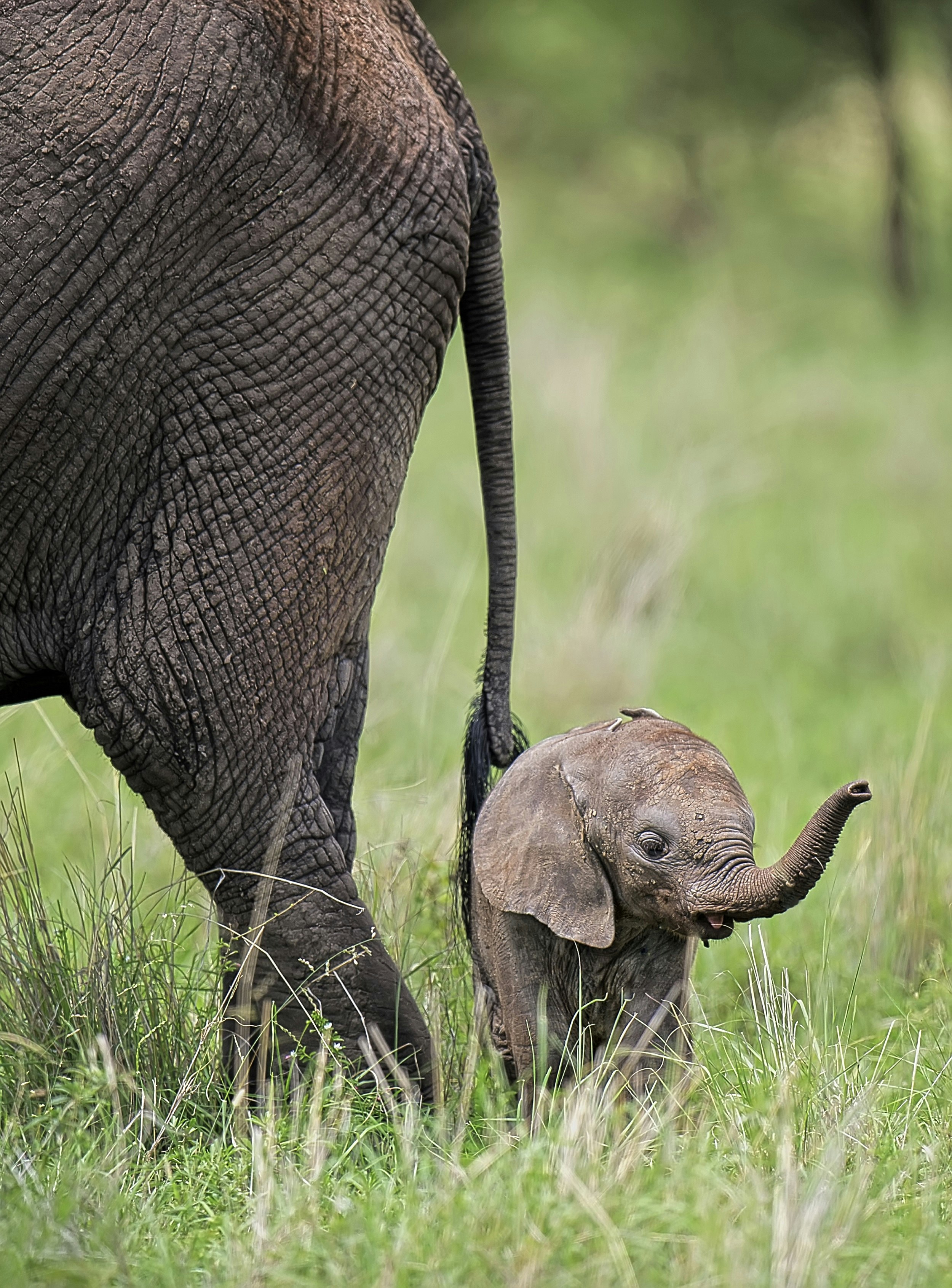
Elephants in peril
Thanks to their tusks and the enduring popularity of ivory (particularly in Asia), elephants have been poached in unsustainable numbers since the 1970s and their numbers have fallen dramatically as a result. The African elephant is listed as vulnerable by the International Union for the Conservation of Nature (IUCN).
In the 1970s and 1980s, poaching caused the numbers of African elephants to crash from around 1.3 million to closer to 500,000. In Kenya, for example, elephant numbers fell from 45,000 in 1976 to just 5400 in 1988. The slaughter ended only in 1989 when the trade in ivory was banned under the Convention for International Trade in Endangered Species (CITES). When the ban was established, world raw ivory prices plummeted by 90%, and the market for poaching and smuggling was radically reduced. The same year, Kenyan President Daniel arap Moi dramatically burned 12 tons of ivory in Nairobi National Park as a symbol of Kenya’s resolve in the battle against poachers.
Malawi's wildlife renaissance

But poaching is again on the rise. Africa has lost more than 30,000 elephants a year since 2010. That’s around 7% of Africa’s elephant population every year. That’s 673 elephants being killed a week, 96 a day. That’s four elephants being killed for their tusks every hour. In 2014, for the first time in decades, a critical threshold was crossed when more elephants were being killed on the continent than were being born.
The 2016 Great Elephant Census recorded a 30% decrease in Africa’s elephant populations in just seven years, although there was good news alongside the bad. Kenya's elephant population, for example, was considered to be "relatively stable" at 25,959, while Uganda's 4864 elephants were cause for optimism after the country's elephant population fell to just 800 during the 1980s. Tanzania, on the other hand, saw a catastrophic 60% decline in elephant numbers in the five years to 2016, with just 42,871 elephants and 2.6 carcasses spotted for every live elephant.
Conservationists anxiously await the next census to learn whether the massive conservation effort to save the elephant has stemmed the tide of elephant killings.
Safari animals: the story of rhinos (and the best places to see them)
This article was first published November 2019 and updated July 2022
Explore related stories
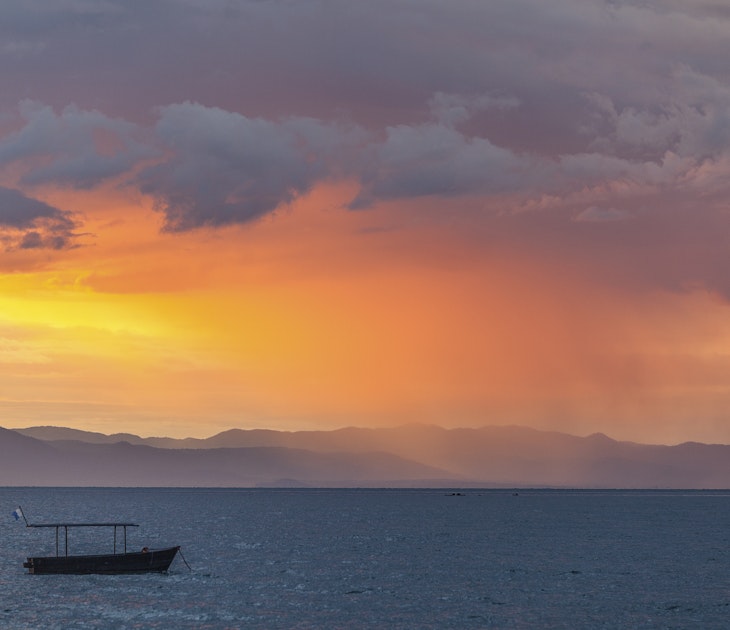
Mar 16, 2023 • 3 min read
Whether it's for wildlife or a slice of lakeside serenity.
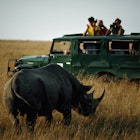
Aug 16, 2022 • 6 min read
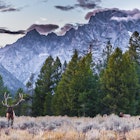
Dec 2, 2021 • 5 min read

Mar 20, 2024 • 8 min read

Mar 4, 2024 • 8 min read

Feb 27, 2024 • 6 min read

Feb 20, 2024 • 17 min read

Feb 19, 2024 • 7 min read

Feb 12, 2024 • 10 min read
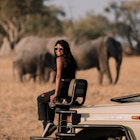
Jan 31, 2024 • 6 min read

- Client Reviews
- Safari Blog
- Send an Inquiry
- Map of Africa
- Contact Details
- African Safari Cost
- Travel Insurance
- You are here
- The Budget Safari Blog
- The best elephant safari…
__large__banner.jpg)
The best elephant safari in Africa? 9 African safaris with elephants galore
Posted by Landia Davies on August 03 2022 in African Safaris & Tours Enquire Now!
Where's the best place to see elephants in Africa? We are often asked which safari parks are best for an elephant safari that's affordable. Luckily there are many fantastic, budget-friendly places to go on safari with elephants. To help you choose, here are 9 of the best elephant safari tours to top African parks.
9 Best Elephant Safari Tours in Africa
These are the 9 best elephant safari tours (and wildlife parks) for an affordable African safari with elephants galore.

As always the African safaris listed below are all guided tours with our reputable 80+ safari partners across the continent. They are the best elephant safaris in Africa for budget-conscious travellers.
East African Elephant Safari Tours
The best places to see elephants in East Africa are Tanzania and Kenya.
1. Kenya Elephant Safari: Amboseli Park & Tsavo National Park
Home to about 1,600 elephants, Amboseli Park is famous for its large herds of big elephants, which include big bulls with impressive tusks. It is one of the best places to see elephants up close in the wild. In Amboseli National Park you can see herds of up to 100 elephants with Mount Kilimanjaro in the background.

Tsavo National Park is renowned for its large elephant herds covered in red dust, hosting over 12,000 elephants in its massive 8,765mi² (22,700km²) area.

5-Day Kenya Lodge Safari in Tsavo & Amboseli Parks - tour price from $2,041 per person
Samburu National Reserve and Masai Mara National Reserve are also top places for elephant safaris in Kenya
2. Tanzania Safari with Elephants: Tarangire Park & Ngorongoro Crater
Tarangire National Park is the best place for an elephant safari in Tanzania, followed by Serengeti National Park and the Ngorongoro Crater. On Tarangire safaris, you can see herds of elephants up to 300 strong! The park hosts over 4,000 elephants. In the dry season (July to October) as many as 3,000 additional elephants migrate into Tarangire Park making this the best time for an elephant safari here.

5-Day Tanzania Safari - Serengeti, Ngorongoro & Tarangire - tour price from $1,870 per person
The nearby Ngorongoro Crater and Serengeti Park host sizeable safari elephant populations year-round.

Lake Manyara National Park is another excellent place to see elephants on safari in Tanzania. It is also located on the Northern Tanzania Safari Circuit , close to Tarangire, Serengeti, and the Ngorongoro Crater.
3. Tanzania Elephant Safari: Ruaha National Park & Nyere (Selous)
For the best elephant safari in Tanzania's southern region, head to Ruaha National Park . This remote Tanzania park is home to high concentrations of elephants with about 15,000 elephants. It hosts the largest elephant population in Tanzania, if not East Africa.
Nyere National Park (formerly Selous Game Reserve) is another top place to see elephants on safaris in Tanzania

8-Day South Tanzania Fly-in Safari to Selous and Ruaha - tour price from $3,995 per person or the cheaper 7-Day Private Tanzania Safari to Mikumi & Ruaha Parks - tour price from $2,400 per person
Southern African Elephant Safari Parks & Tours
In southern Africa, Botswana, South Africa, Zambia, and Zimbabwe are the best places for a safari with elephants aplenty, followed by Namibia.
4. Botswana Safari with Elephants: Chobe Park & Okavango Delta
Chobe National Park and the Okavango Delta are both located in Northern Botswana which hosts the largest elephant population in the world, with over 120,000 elephants living in the region. Chobe Park is the best place for elephant safaris in Botswana hosting high concentrations of these gentle giants. The elephant population of Chobe Park is estimated at about 50,000, or more when elephants migrate into the park.
5-Day Chobe & Okavango Delta Lodge Safari - tour price from $3,321 per person

5. Zambia Elephant Safari: South Luangwa National Park
South Luangwa Park is home to the bulk of Zambia's elephants supporting over 14,000 elephants. You are likely to see large elephant herds roaming free on safari here. Better still, South Luangwa National Park is one of the best places to encounter elephants on foot in Africa. This Zambian park is the birthplace of the walking safari in Africa.

5-Day South Luangwa Tented Camping Safari - tour price from $2,512 per person
6. South Africa Elephant Safari: Kruger Park
Kruger Park is the best place for an elephant safari in South Africa. Kruger National Park is home to about 20,000 elephants!
Located in northern South Africa, this massive national park is one of the best places in Africa to see elephants, along with the other Big 5 animals (rhino, lion, leopard, and buffalo).

5-Day Kruger National Park Safari - Tented Camping - tour price from $882 per person
7. South Africa Safari with Elephants: Addo Elephant National Park
Addo Elephant Park rivals Kruger as the top destination to safari with elephants in South Africa. It is home to over 600 elephants but within a much smaller area. Addo Elephant National Park hosts high concentrations of elephants. So, you're more likely to see an abundance of African elephants on a safari here.
The third largest national park in the country, Addo Elephant Park is located on the south coast of South Africa. It is the best place for elephant safaris in South Africa , outside of Kruger Park.

5 Day Addo Park & Kariega Big 5 Safari - tour price from $2,160 per person

8. Namibia Elephants Safari: Etosha National Park
Over 2,500 elephants inhabit Etosha National Park in northern Namibia. The elephants of Etosha are the tallest in Africa and they display rare adaptations to the desert-like conditions of the Etosha Pan. The elephants of Etosha are easy to see in the dry environment of Etosha. Elephant watching is superb, especially in winter when they gather at waterholes scattered across the arid landscape.

5-Day Affordable Etosha Lodge Safari - tour price from $1,760 per person
9. Zimbabwe Elephant Safari: Hwange National Park
Zimbabwe's Hwange National Park is one of the best places for elephant safaris in Africa. It hosts over 40,000 elephants in an area of only 5,657mi² (14,651 km²).

6-Day Zimbabwe Safari - Victoria Falls & Hwange Lodge Safari - tour price from $2,589 per person
Another top place to see African elephants on safari in Zimbabwe is Mana Pools National Park.
Best Places to Safari with Elephants in Africa (and the Big 5)
Now that you've seen some of the best elephant safari tours in Africa, get in touch and book your favourite one!
__large__medium.jpg)
Or, take a closer look at the top elephant safari destinations in Africa to help you figure out which is best for you. Is it the watery delta, open savannahs, rugged bushveld, or dramatic salt pans that will steal your heart? Each of these elephant hotspots is close to different attractions and natural wonders, offering travellers a wide array of different activities and African experiences.
Find out more in the 11 Best Places to See Elephants in Africa (in the wild) and the Best Places to See Africa's Big 5 (lions, leopards, rhinos, buffalos, and elephants).
Alternatively, get advice from a friendly travel expert at African Budget Safaris for help planning your ideal safari with elephants for Africa.

If you liked this post, these trips cover similar ground…
- 3 Day Addo Elephant Park Safari in South Africa
- 3 Day Etosha Private Safari in Namibia
- 10 Day Botswana Safari: Moremi, Mababe & Chobe
- 3 Day Budget Kruger Safari - Backpackers Tour
- 7 Day Victoria Falls, Hwange & Chobe Safari Tour
- 5 Day South Luangwa Tented Camping Safari
- 6 Day Budget Amboseli, Lake Nakuru & Masai Mara Safari
- Kenya Safari: Masai Mara, Tsavo & Amboseli
- 5 Day Tanzania Safari - Serengeti, Ngorongoro & Tarangire
- 8 Day Private Tanzania Safari to Nyerere & Ruaha (Fly-in Tour)
- 9 Day Botswana Safari Adventure: Delta & Chobe Small Group Tour
- 7 Day Samburu, Lake Nakuru & Masai Mara Safari in Kenya
About the Author
Landia davies wordsmith & sculptor.

Places Mentioned in this Post
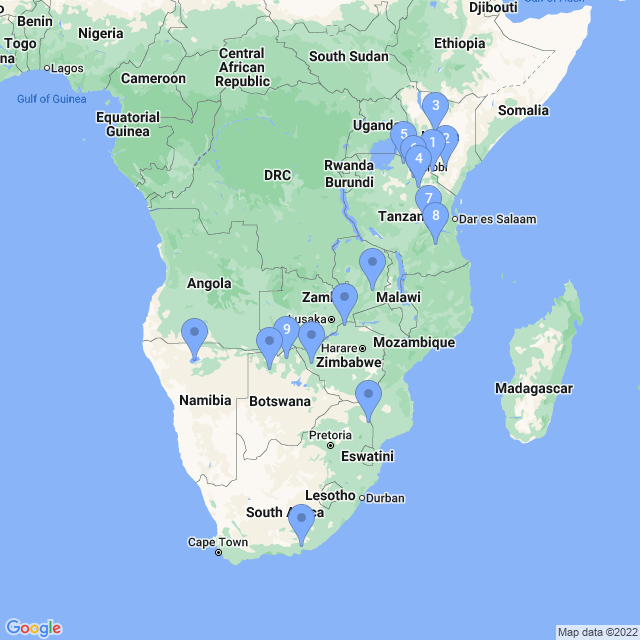
1. Amboseli National Park, Loitoktok District, Rift Valley, Entonet, Kenya
2. Tsavo East National Park, Tsavo national park, Kenya
4. XXVH+PGJ Tarangire National Park, Tanzania
5. Serengeti, Tanzania
6. Ngorongoro Crater, Tanzania
7. Great Ruaha River, Tanzania
8. 2G22+225, Mkangira, Tanzania
9. 7C9H+QMG Chobe National Park, Kakoaka, Botswana
10. Okavango Delta, Botswana
11. TIME + TIDE MCHENJA CAMP, South Luangwa National Park, Zambia
12. Kruger National Park, South Africa
13. Addo Elephant National Park, Addo, 6105, South Africa
14. Hwange National Park, Zimbabwe
15. Etosha National Park, Namibia
16. Mana Pools National Park, Zimbabwe
Similar & Related Blog Posts
Below you’ll find further reading and articles related or similar to this post.
11 Best Places to See Elephants in Africa (in the wild)
Landia Davies | January 30 2020

Did you know? Fun Facts About the Big 5 Animals and Other Wildlife in Africa!
Chris Du Preez | May 08 2020

The Last Elephants & how to help save elephants in Africa
Landia Davies | April 15 2019

The Big 5 of Africa & Where to See These Famous Big 5 Animals
Landia Davies | March 02 2024

8 Endangered African Animals and the Best Places to See them
Andrew Hofmeyr | May 13 2018

Most Endangered Animals in Africa - Where to See them & How to Help
Landia Davies | August 21 2018

The Marine Big 5 Animals of South Africa - the Cape’s Top Sea Life
Andrew Hofmeyr | November 03 2016

Are there any Big 5 Safaris in Cape Town, South Africa?
Briony Chisholm | April 25 2018

Stand back Big 5 animals: Bring on the Shy 5, the Ugly 5 and the Small 5 animals in Africa
Briony Chisholm | January 10 2024

The Big Kruger Game Viewing Guide: expert Kruger National Park Safari Tips
Miles Masterson | May 09 2019

Cheetah vs Leopard: What’s the difference between these African big cats?
Kate Explorer | December 21 2023

How to spot a leopard on your African safari: top Big 5 safari tips for seeing leopards
Briony Chisholm | October 25 2018

Private Group?
A private, tailor-made safari is within your reach. Experience all of your bucket-list safari related items on a budget now.

Search form
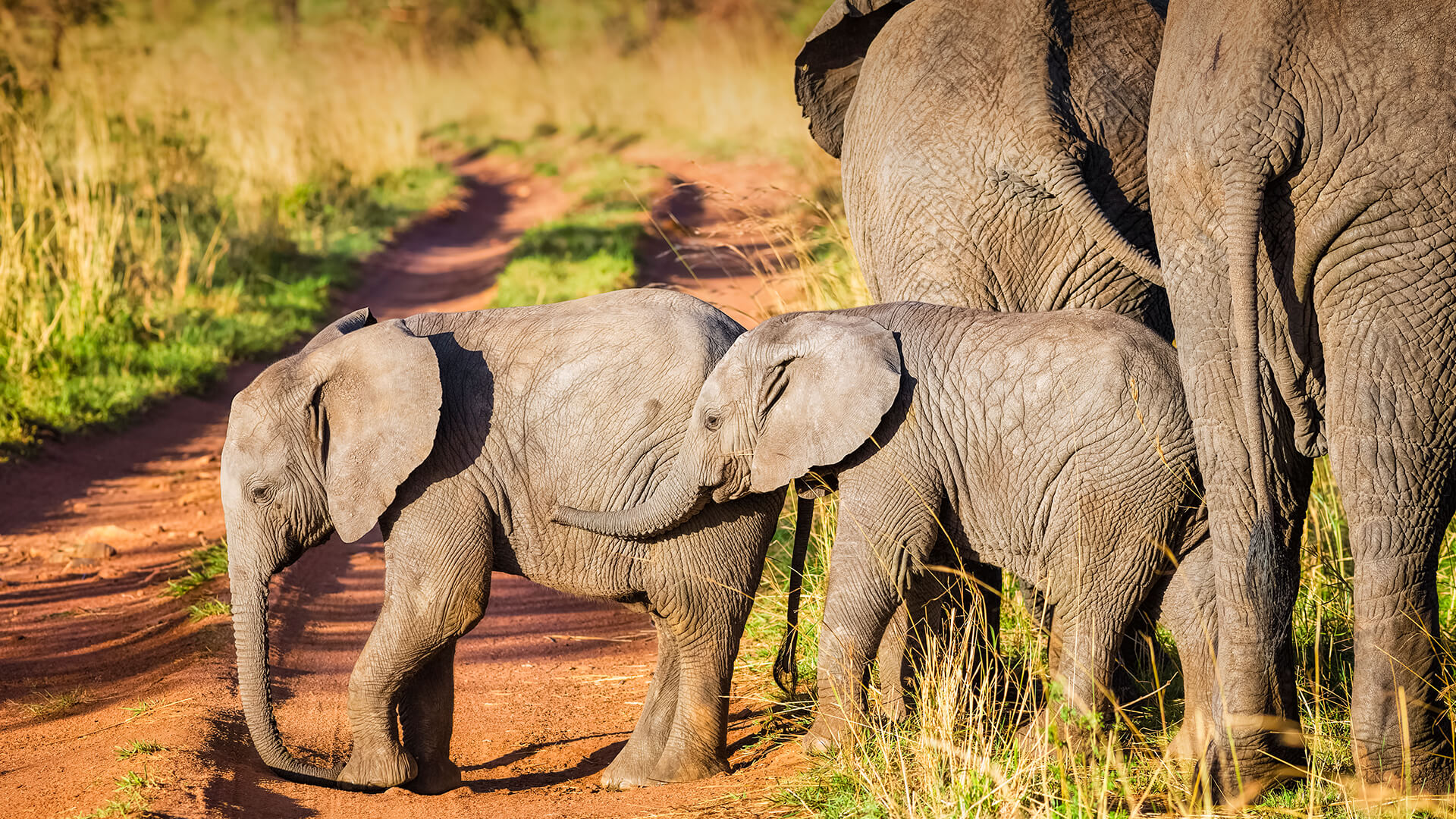
- Class: Mammalia (Mammals)
- Order: Proboscidea
- Family: Elephantidae
- Genera: Loxodonta (African) and Elephas (Asian)
- Species: africana, cyclotis, and maximus
- Subspecies: E. maximus indicus (Indian), E. maximus maximus (Ceylon), E. maximus sumatranus (Sumatran)
Have you “herd”? They’re enormous and intelligent, strong and sociable. Humans have been impressed by elephants for centuries, simply because they are so big—a male African elephant can weigh up to 7.5 tons (6.8 metric tons)! They also amaze us with their long and flexible noses, large and flapping ears, and loose, wrinkly skin. There are many stories about elephants—you’ve probably heard of Horton, Babar, and Dumbo.
If all elephants seem the same to you, take a closer look. There are three types of elephants that are usually recognized: the African savanna elephant, the African forest elephant, and the Asian elephant. There is some ongoing debate about how many subspecies may exist, or whether some of these might, in fact, be species in their own right. Here are a few ways to tell them apart:
- African elephants (both species) have large ears that are shaped like the continent of Africa, both males and females have visible tusks, their skin is very wrinkly, their back is swayed, and the end of their trunk works as if they have two fingers there to help them pick things up. African elephants are the largest mammals on land.
- Asian elephants have smaller ears, usually only the males have visible tusks, they only have one “finger” at the end of their trunk, and their back is dome-shaped.
Cool ears! An elephant’s ears are a like an air conditioner. As elephants flap their ears on a hot day, the blood flowing through the many blood vessels in the ears is cooled. If they have just splashed around in a river, all the better! This ear flapping behavior cools their large bodies on warm days.
The skinny on skin. The term “pachyderm” is from the Greek word pachydermos , which means “thick skinned,” and this term often refers to elephants, rhinos, and hippopotamuses.
An elephant’s skin can be up to 1 inch (2.54 centimeters) thick on some parts of its body. It’s also loose, which makes the elephant look like it’s wearing baggy pants or sagging stockings. But there’s a good reason for this—it keeps the elephant cool by trapping moisture that takes longer to evaporate. And even though it’s thick, an elephant’s skin is also very sensitive to touch and sunburn. Elephants often spray themselves with water or roll in the mud or dust for protection from the sun and biting insects.
Really long in the tooth. Tusks are an elephant’s incisor teeth and are the only incisors an elephant has. They are used for defense, digging for water and food, and lifting things. The tusks present at birth are milk teeth, which fall out after a year when they are about 2 inches (5 centimeters) long. Permanent tusks extend beyond the lips at about two to three years and grow throughout an elephant’s life.
The tusks are composed of ivory (dentine) beneath the outer layer of enamel, but the peculiar diamond pattern of the elephant’s tusk gives it a distinctive luster that ivory tusks of other mammals such as hippos, warthogs, walruses, and sperm whales don’t have, and African elephants are sometimes killed by poachers just for their ivory tusks.
Elephants also have four molars, one on the top and one on the bottom on both sides of the mouth. One molar can weigh about 5 pounds (2.3 kilograms) and is the size of a brick! Each elephant can go through up to six sets of molars in its lifetime.
New teeth do not erupt vertically, as in most mammals, but grow in from behind, pushing the old worn-out teeth forward and out, like a production line of teeth moving along the jaw from back to front. In very old elephants, the last (sixth) set of molars can become sensitive and worn down, and the elephants they prefer to eat softer food. Marshes are the perfect place for soft plant food, so old elephants are often found there. Many times they stay there until they die. This practice led some people to think that elephants went to special burial grounds to die.
The nose knows. An elephant’s trunk is both an upper lip and a nose. There are 8 major muscles on each side of the trunk and 150,000 muscle fascicles (portions of muscles) for the entire trunk. There are no bones or cartilage in this unique appendage. An elephant’s trunk is so strong it can push down trees and so agile that it can pick up a single piece of straw. Elephants also use their trunk like we use our hands: to grab, hold, pick up, reach, touch, pull, push, and throw.
The trunk is still a nose, too, and has two nostrils at the end that suck air up the long nasal passages and into the lungs. Elephants also use their trunks to drink, but the water doesn’t go all the way up the nose like a straw; instead, the elephant sucks water only part way up the trunk, curls it toward its mouth, tilts its head up, and lets the water from the trunk pour in.
Sounds of music. Elephants make many different sounds; humans cannot hear some of these sounds, as their frequency is too low for our ears. Elephants use these sounds to communicate with each other over long distances. Have you ever had your stomach growl at an unfortunate moment? Well, stomach growls are a welcome sound in elephant society; a stomach that makes loud rumbling and growling noises seems to signal to others that everything is “okay.”
The largest elephant on record was an adult male African savanna elephant. He weighed about 24,000 pounds (10,886 kilograms) and was 13 feet (3.96 meters) tall at the shoulder! Most elephants don’t get that large, but African elephants do grow larger than Asian elephants.
HABITAT AND DIET
Home is where the herd is. Asian elephants live in India, Nepal, and parts of Southeast Asia. Their habitat is scrub forest and rainforest, and they are often found along rivers during dry months.
African savanna elephants ( Loxodonta africana ) are found in eastern, central and southern Africa, living in lowland and montane forests, flood plains, and all types of woodland and savanna. The smaller African forest elephants ( Loxodonta cyclotis ) inhabit the Congo basin and western Africa in moist, semi-deciduous rainforests.
Elephants eat all types of vegetation, from grass and fruit to leaves and bark—about 165 to 330 pounds (75 to 150 kilograms) each day, which is about 4 to 6 percent of their body weight. They spend an average of 16 hours per day eating! African elephants are grazer-browsers and eat grasses, including sedges, flowering plants, leaves, shrubs, and small- to medium-size trees. African forest elephants are browser-frugivores and eat leaves, fruits, seeds, branches, and bark. Asian elephants are both browsers (feeding on shrubs and trees during the dry season and after heavy rains) and grazers (feeding on grass during the first part of the wet season). They can consume many types of plants, including twigs and bark. The choice of plants varies with seasons.
The elephants at the San Diego Zoo and the San Diego Zoo Safari Park eat a bit less than their counterparts on the savanna—about 125 pounds (57 kilograms) of food each day—because they don’t have to burn as many calories looking for food. Still, the adult male African elephants at the Safari Park need to eat over 70,000 calories each day! Our elephants are offered hay, herbivore pellets, acacia browse, celery, cucumbers, and lettuce daily. Elephants drink 20 to 50 gallons (75 to 190 liters) of water each day.
FAMILY LIFE
Most elephants live in close social groups called herds, usually made up of related females and their offspring. The leader of the herd is known as the matriarch; she is usually the oldest and most experienced female in the group. The matriarch remembers where and how to find food and water, how to avoid predators, and the best places for shelter. She also keeps the younger elephants in line and teaches them how to behave in elephant society. In some cases the group may include one of the matriarch’s sisters and her offspring. When groups get too big, “bond groups” split off but maintain a loose association.
Adult males don't usually live in a herd. Once male elephants are old enough to find their own food and protect themselves, they leave the herd and live on their own or form bachelor herds with other males. Only after they become adults do they visit herds of females, and that is only for short periods of time to breed. Bulls do not take part in caring for the young.
Ellie etiquette. Good manners are important in elephant society. Trunks are used in greeting: a lower-ranking individual will insert its trunk tip into the other’s mouth. A trunk may be held out to an approaching elephant as a greeting and is also used in caressing, twining, wrestling, and checking reproductive status.
Stranger danger. Elephant calves could be a potential meal for hyenas, lions, leopards, or crocodiles, but as long as they stay near Mom or their herd, they have little to worry about. If an elephant senses danger, it trumpets a loud alarm call to alert the others. The herd then forms a protective ring, with youngsters in the middle and the adults facing out to confront a potential predator. A healthy adult elephant’s only foe is a human poacher with a powerful rifle.
At birth a baby elephant, called a calf, may stand three feet (one meter) tall. A calf is usually quite hairy, with a long tail and a very short trunk, and is very dependent upon its mother and other members of the herd. The little one uses its mouth to drink its mother’s milk, so it doesn’t need a long trunk to feed. Calves stick close to Mom and nurse frequently; they gain, on average, 2 to 3 pounds (1 to 1.3 kilograms) a day in their first year! Herd mates tend to look out for the calves.
Despite all the playtime and protection, calves still have to navigate through social nuances and establish their social rank within the herd. Babies spend their days practicing making all four legs go in the same direction at the same time, perfecting their ear flaring, and mastering trunk control. Calves are clumsy at first with their trunk, but they learn to use it as they grow older. By the time they are two to three years old, they no longer need to nurse.
Empress and Queenie were the San Diego Zoo’s first elephants, arriving here in 1923 via train from San Francisco. After being led off the train, the two Asian elephants refused to move another step, no matter how much encouragement they received. The Zoo’s founder, Harry Wegeforth, M.D., was there to greet them, and it occurred to him that they were probably used to being ridden, so he climbed up on Empress and another staff member did the same with Queenie, and off they walked from the train station to the Zoo, gathering many astonished looks along the way!
Peaches was the San Diego Zoo’s first African elephant—and she made sure to be a memorable one, too. When she arrived in 1953, she was three years old, smart, curious, and, as then ZOONOOZ editor Ken Stott described her, “playful as a quarter-ton kitten.” She had made the journey from Africa to San Diego with elephant care specialist Ralph “Gabe” Davis, and they got along famously—at least most of the time. When Gabe gave her breakfast, she would grumble and trumpet at him until he left her alone to eat—apparently, she was not sociable in the morning. She also showed a marked preference for men, even pushing away Zoo Executive Director Belle Benchley when she tried to say hello. Peaches did become more mellow as she grew up, but even as an adult, she still had a way of “flirting” with men while more often than not giving women a cool stare.
Visit African savanna elephants at the San Diego Zoo’s Elephant Odyssey. It features our world-class Elephant Care Center, with state-of-the-art assistive technology that allows us to offer highly specialized care for elephants with unique physical needs.
To best care for elephants at both the Zoo and the Safari Park , elephant care specialists teach them to offer various areas of their body as part of their ongoing healthcare. Whether daintily presenting a foot, patiently standing parallel for a bath, or offering up their trunk for a saline flush, elephants participate in their own wellness and self-care routines.
The African savanna elephants we care for at the San Diego Zoo Safari Park are one of the most genetically significant African elephant herds in North America and this conservation effort helped us earn the Association of Zoos and Aquariums’ 2014 award for significantly enhancing the conservation of a species.
Elephants have spent millions of years patrolling the parched African landscape following ancient mental maps to water sources, so it’s no wonder that swimming pools and mud wallows are a big hit with elephants, too. On warm days, guests may experience views of the Park’s entire herd cavorting about in the pool, spraying each other with trunks full of water, and horsing around with their friends in the sun.
CONSERVATION
Today's native elephant populations face threats from poaching, habitat loss and fragmentation, and coexistence with people. Poaching is a major cause of population decline in all elephants, and the leading cause of decline in African forest elephants. Despite the knowledge that their tusks are made of ordinary dentine, like our teeth, consumers continue to illegally purchase elephant tusks, so poachers persist in illegally hunting elephants. Elephants are now protected, but poachers still hunt them, and they face other life-threatening challenges, too. As populations of people expand, elephant habitats shrink. Growing farms and developing infrastructure to support people often disturb or displace elephants. This can not only lead to a loss of suitable habitat for elephants, but can also create conflict between people and elephants when they compete for resources.
Asian and African savanna elephants are listed as Endangered on the International Union for Conservation of Nature Red List of Threatened Species. African forest elephants are Critically Endangered.
We support and advance elephant conservation through a variety of methods, including elephant behavior and reproductive biology. We apply the knowledge we learn from caring for the elephants at the Zoo and Safari Park to help protect and conserve elephants across their native habitats. In one multidisciplinary approach, our scientists record elephant auditory communication and behavior for a clearer understanding of the social dynamics of a herd and the relationship between mother and calf. In another, we document and study calf weights as a measure of health.
To care for the long-term health and sustainability of elephant populations, we share bull elephant semen with other conservation scientists to support the genetic diversity of elephants in North America. To further care for their reproductive health, we closely observe elephant hormone levels to uncover the details of their complex estrous cycles.
To understand how elephant activity levels at the Safari Park compares to elephant activity levels in Africa, our conservation scientists studied elephants' movement patterns with the help of movement-based GPS technology. Our team found that eight elephants at the Safari Park walked an average of 3 to 7 miles (5 to 11 kilometers) per day, and walked the most during the middle of the day. These distances are comparable with what has been observed in elephants in Africa. Also, the relationship of the walking rate and time of day mirrors activity patterns observed in some populations of elephants in Africa.
Collaborative Partnerships. We work with partners across Africa to advance elephant conservation through land preservation, scientific study, rehabilitation, and by promoting peaceful coexistence between people and elephants.
In Kenya, we work with Kenya Wildlife Service, Save the Elephants, and the Northern Rangelands Trust to help local ecologists and rangers conserve populations while reducing often deadly human-elephant conflict in the area. We also partner with the Reteti Elephant Sanctuary, where wildlife care specialists rehabilitate, raise, and eventually rewild orphaned African elephants.
The small country of Botswana is home to the largest elephant population remaining on the African continent. San Diego Zoo Wildlife Alliance has partnered with Elephants Without Borders (EWB) to delve further into questions about elephants, their behavior, and the best ways to help conserve them. To do this, we study blood samples in ongoing genetic studies, and fecal samples to learn about diet and stress in elephant populations. These insights help us understand health conditions and possible motives for elephant travels.
Elephants Without Borders has been observing elephant movement throughout northern Botswana since 2000, having tracked over 90 individual elephants; this is one of the longest and largest elephant movement studies in Africa. Every individual elephant has a unique character and intriguing story to his or her own seasonal march, preferred routes, and favored places. Each elephant offers unique insight and helps us learn more about elephant ecology. Unpredictable individual ranging behavior coupled with a dynamic, ever-changing environment in Botswana underscore the need for long-term elephant studies. Elephants are observed from a fixed-wing plane, which allows a visual assessment and helps scientists learning more about herd structure and habitat use.
In collaboration with San Diego Zoo Wildlife Alliance, Elephants Without Borders has established a conservation farming project in the Chobe Enclave in Botswana. This project is developing plots with various methods of protection. Along with aerial survey wildlife counts and elephant movement data, these projects are essential for developing community-based conservation programs to promote peaceful coexistence between people and elephants and make better-informed conservation decisions for all.
In addition, San Diego Zoo Wildlife Alliance has developed groundbreaking anesthesia techniques that are used at other zoos and can be offered, when needed, to care for elephants across native habitats by our partners and other veterinary experts in the field. San Diego Zoo Wildlife Alliance is also an active member of the International Elephant Foundation. All of these efforts allow us to continue to offer world-class care for elephants and to conserve elephants across Africa and Asia.
By joining San Diego Zoo Wildlife Alliance as an ally for wildlife, you help save wildlife worldwide.

38 to 47 years median life expectancy
Gestation: 20 to 22 months
Number of young: 1
Weight at birth: 110 to 264 pounds (50 to 120 kilograms)
Height at birth: 26 to 42 inches (66 to 107 centimeters)
Maturity: 13 to 20 years old
Height at shoulder: Females average 8 feet (2.4 meters), males average 10 to 10.5 (3 to 3.2 meters)
Weight: African elephant females up to 8,000 pounds (3.600 kilograms), males up to 15,000 pounds (6,800 kilograms)
Weight: Asian elephant females about 6,000 pounds (2,720 kilograms), males 11,000 pounds (nearly 5,000 kilograms)
An elephant’s skin is so sensitive that it can feel a fly landing on it.
The low, resounding calls elephants make can be heard by another elephant up to 5 miles (8 kilometers) away.
Elephants have been relentlessly slaughtered for their tusks, even though the tusks are made of dentine–the same as our teeth.
In India’s Andaman Islands, elephants swim across the sea between the islands.
An elephant’s skull weighs about 115 pounds (52 kilograms); it would be even heavier without honeycomb-like spaces that reduce the skull's weight.
Elephants favor either their left or right tusk. One tusk usually shows more wear than the other.
Frequent bathing and showering, as well as powdering with dirt, is an important part of elephant skin care.
Unlike other mammals, elephants grow throughout their lifetime.
Are elephants afraid of mice? We’d rather say they seem annoyed by small animals and either try to frighten or flatten them.
Elephants do sleep for a couple of hours while lying down—our elephant care specialists have even heard them snoring.
A 14,000-pound (6,300-kilogram) African elephant is able to carry up to almost 20,000 pounds (9,000 kilograms).
Elephants at the San Diego Zoo and San Diego Zoo Safari Park eat up to 125 pounds (57 kilograms) of food each day, and they each deposit about 300 pounds (136 kilograms) of poop daily. How is this possible? It’s due to all the water they drink.
“An elephant never forgets?” Our wildlife care specialists feel that, just like people, elephants seem to especially remember good times and bad and seem to have good memories for individual people.
What do you call a group of elephants? A parade.
DISCOVER WILDLIFE
More animals & plants from san diego zoo and san diego zoo safari park.


- +44 (0)7788 194 180
- [email protected]
- USD $ EUR € GBP £ JPY ¥ CHF CHF CAD C$ AUD $ NZD $ ZAR R INR ₹ CNY ¥ Login Register Enquire Now
Are you looking for a wildlife safari?
JOIN to get fantastic deals, leave reviews and be part of our safari community.
Are you a responsible operator planning amazing wildlife safari?
JOIN our safari community to connect with travellers looking for wildlife experiences. Display your best trips and get direct referrals from SafariDeal.com
Login to Your Account
Register as a traveller.
Get access to even better safari deals from our 1996 Travel Partners. These could be last minute or specially negotiated deals, just for you.
Congratulations, you have successfully registered.
Thank you. The Safari Deal Team
Request A Custom Quote
Your details.
Contact Number
Country of Residence
Plan Your Safari
Safari Destination Borneo China India Kyrgyzstan Mongolia Nepal Russia Sri Lanka Vietnam Cameroon Democratic Republic of Congo Belize Guatemala Burundi Ethiopia Kenya Rwanda Tanzania Uganda Azores Finland Iceland Norway Portugal Serbia Slovakia Slovenia Spain Sweden Iran Jordan Morocco Canada Mexico Argentina Brazil Chile Colombia Ecuador Falkland Islands Guyana Patagonia Peru St Helena Botswana Madagascar Malawi Mozambique Namibia South Africa Swaziland Zambia Zimbabwe Ghana
Total Budget Per Person
GBP (£) USD ($) EUR(€)
Total Adults
Total Children 0 1 2 3 4 5 6
Child 1 age 1 2 3 4 5 6 7 8 9 10 11 12 13 14 15 16
Child 2 age 1 2 3 4 5 6 7 8 9 10 11 12 13 14 15 16
Child 3 age 1 2 3 4 5 6 7 8 9 10 11 12 13 14 15 16
Child 4 age 1 2 3 4 5 6 7 8 9 10 11 12 13 14 15 16
Child 5 age 1 2 3 4 5 6 7 8 9 10 11 12 13 14 15 16
Child 6 age 1 2 3 4 5 6 7 8 9 10 11 12 13 14 15 16
Travel Dates
Tell us more about your ideal safari
We care about your data. Read our Privacy Policy here
- Where to See Elephants in Africa: the 10 Best Safari Destinations to Visit

African elephants, the largest land mammal, are intelligent creatures with studies suggesting that elephants are as smart as chimpanzees and dolphins. The African bush (or savanna) elephant, is the largest of the three species of elephants (the two others being the African forest elephant and the Asian forest elephant), spread throughout the African continent and found in many African countries.
In some regions, the elephants have adapted to harsh climates, such as the Sahara and Namib deserts, but due to the lack of water, it is not so easy to see these elephants in the desert regions. It is more common to see them in landscapes of open plains and lush vegetation. To help you decide where to head to spot elephants, we have curated a list of Africa’s premium safari destinations with the largest populations of elephants in Africa.
1. Chobe National Park, Botswana
2. hwange national park, zimbabwe, 3. okavango delta, botswana, 4. selous game reserve, tanzania, 5. kruger national park, south africa, 6. mana pools national park, zimbabwe, 7. tsavo conservation area, kenya, 8. serengeti national park, tanzania, 9. amboseli national park, kenya, 10. masai mara national reserve, kenya, other african safari destination where you can see elephants:.
Number of Elephants: Over 120,000
Best months to visit: May to October
Botswana has the greatest population of elephants in Africa, with Chobe National Park in the north of the country home to the largest population of elephants in the whole of Africa. The diverse habitats of Chobe, including mopane woodlands, acacia woodlands, baobab trees, and flood grasslands, offer a rich feeding ground for its huge elephant population.
In the dry season, elephants gather around the Chobe and Linyanti Rivers, so a boat cruise along the river or game drive along the bank is perfect for watching elephants.
Chobe National Park is home to all of Africa’s big five animals , including the elusive leopard and the endangered rhinoceros, as well as being a renowned birding destination.
Recommended Safari: 7 Day Chief’s Island & Chobe National Park Family Safari
A premier African safari destination, Botswana offers amazing safaris from top rated safari experts.
Number of Elephants: Around 20,000-50,000 individuals
Best months to visit: July to October
Hwange National Park has the largest elephant population in Zimbabwe. In fact Hwange’s wildlife authorities are struggling to handle the elephant overpopulation with the adverse effects it has on the ecology. However, from a safari perspective, Hwange offers excellent chances of spotting large herds of elephants throughout the park.
In addition, the Hwange ecosystem is home to around 500-700 lions as well as the remaining big five animals and many more wildlife species together with diverse bird life.
Recommended Safari: Zimbabwe Highlights Safari
Number of Elephants: Over 18,000
Although Okvango’s elephant numbers may not be as staggering as that of Chobe National Park, it has a decent elephant population. The Okavango Delta’s unique ecosystem is known for its seasonal flooding that replenishes the region’s water sources while the Delta itself provides a perennial water sources attracting elephants and much other wildlife throughout the year.
The Okavango Delta also offers excellent bird-watching opportunities, stunning aerial views, diverse wildlife, and a chance to experience the spectacular landscape by traditional mokoro (dugout canoe), by boat and on foot.
Recommended Safari: Zambia, Zimbabwe & Botswana Safari
Number of Elephants: Approximately 15,000
Best months to visit: June to October
Selous Game Reserve has Tanzania’s largest concentration of elephants. One of the less-visited safari destinations, Selous Game Reserve offers elephant habitat with miombo woodland, savanna, wetlands and the Rufiji River The elephant herds have a favourite food, the red fruit of the doum palm, which is found in Selous Game Reserve.
Selous is also one of the few wildlife reserves where you can see the puku antelope, sable antelope and African wild dog. Game activities include walking safaris, game drives, boat trips and, for the more adventurous, fly camping.
Recommended Safari: 3 Days Safari to Selous Game Reserve
Number of Elephants: Over 13,000
Best months to visit: May to September
Kruger National Park , one of Africa’s biggest wildlife reserves at nearly 2 million hectares, has one of the largest elephant populations in South Africa. Kruger’s current elephant population is a credit to the rigorous conservation methods of the park authorities and other non-profit organisations. Due to their large numbers, it is fairly easy to spot these huge mammals throughout the park.
South Africa’s oldest national park, Kruger is home to the big five as well as hundreds of other wildlife species and over 500 bird species.
Recommended Safari: Vic Falls, Kruger & Cape Town .
Number of Elephants: Over 12,000
After Hwange National Park, Mana Pools National Park is the best destination to see elephants in Zimbabwe. A UNESCO World Heritage site, Mana Pools boasts spectacular scenery along the Zambezi River and surrounding floodplains, teeming with wildlife and elephants.
The river channels and small lakes of Mana Pools are an ideal habitat for a healthy population of hippos and Nile crocodiles. The park is one of the best places to go on a boat or canoe safari, watching the wildlife as they drink at the river.
Recommended Safari: 9-Day Highlights of Zimbabwe Safari
Our in-country experts will give you the best travel advice and assist you in creating your perfect safari for 2023.
Number of Elephants: Approximately 12,000
The Tsavo Conservation Area, comprising Tsavo East National Park, Tsavo West National Park, Chyulu National Park and Mkomazi National Park in Tanzania as well as other wildlife reserves, ranches and settlements, is home to the biggest population of elephants in Kenya. Over the years there has been a steady growth in the elephant population due to a dramatic reduction in poaching.
This vast area has remarkable biodiversity and diverse landscapes including acacia scrub, savanna grassland, woodland and riverine forest. It’s home to many species of wildlife including the critically endangered hirola.
Recommended Safari: 4-Day Tsavo East & West Safari
Number of Elephants: Over 7,000
Best months to visit: July to September
Tanzania’s most popular park, Serengeti National Park is well known for its wildebeest migration , it has many other attractions, including a good concentration of elephants, iconic big five, more than 500 bird species, herds of wildebeest and zebra.
In the Serengeti, elephants are an impressive sight, roaming the plains, wandering into the woodlands and drinking from waterholes.
Recommended Safari: 5 Days Safari in Tanzania (Tarangire, Serengeti and Ngorongoro Crater)
Number of Elephants: Over 3000
Best months to visit: January, February, June to October Known for its large elephant herds, sometimes up to 100 elephants, Amboseli National Park also boasts the spectacular backdrop of snow-capped Mount Kilimanjaro, Africa’s highest peak. Amboseli holds the record for the longest elephant tusks and largest elephants.
Amboseli is also a great birding destination with some rare and endangered bird species, such as the Egyptian vulture, and is home to four of the big five (no rhinos).
Recommended Safari: 3-Day Amboseli National Park Camping Safari
Number of Elephants: Approximately 2500
Last, but by no means least, on the list of the best elephant safari destinations is Kenya’s Masai Mara National Reserve . The Masai Mara has a large concentration of wildlife and a bounty of attractions, with elephants often seen on the plains, around the marshes and in the riverine forests. The population of elephants is steadily rising due to the hard work of the rangers, Masai community and the government.
The Masai Mara National Reserve also plays its part in the annual wildebeest migration of over two million wildebeest, zebra and other antelope as they cross the Mara River from Tanzania into Kenya.
Recommended Safari: 3-Day Luxury Masai Mara Safari
- Addo National Park
- The Chyulu Hills
- Tarangire National Park
- South Luangwa National Park, Zambia
- Samburu National Park
- Etosha National Park
- Lewa Wildlife Conservancy
- Mashatu Game Reserve/li>
Our expert in-country travel partners are ready to help you create your dream safari.
- previous
- next
- African family safaris
- African safari
- Elephants in Africa
About author
Content by in-house writer or as indicated on the blog post.
No Comments
Leave a reply.
Your email address will not be published. Required fields are marked *
Cancel reply
Other related posts.

- Safari Deal
Serengeti balloon safari – Breathtaking wildlife views & luxury bush breakfasts
Embark on an incredible journey with Nyssa Balloon Safaris, where the majestic Serengeti unfolds beneath...

The Ultimate Kenya Safari Photography Guide: Exploring Kenya Through Your Lens
To the amateur photographer, Kenya presents a world of photographic opportunities as one of Africa’s...

Guided Safari Tours vs. Self-Drive Safaris in Kenya!
Kenya is a land of vast savannahs, dramatic landscapes, and wildlife spectacles that will leave you breathless....

Birdwatching Safaris in Kenya: Your Ultimate Q&A Guide
Kenya, known in wildlife safari circles for its vast savannahs, majestic wildlife, and coastal beauty,...
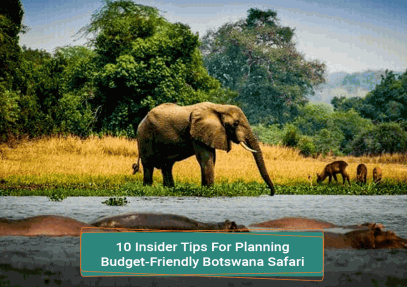
10 Insider Tips For Planning Budget-Friendly Botswana Safari
Botswana, a captivating safari destination, entices travellers with its vast wilderness and commitment...

Expert Tips for Choosing an Experienced Safari Tour Operator
Planning and embarking on a safari is an exciting thing and it could turn out to be an adventure of a...

7 Things You Must Pack for Your African Safari
Get ready for an unforgettable African safari experience, where you can immerse yourself in the stunning...

Birding Safari in Victoria Falls
A birding safari in the Victoria Falls area is fantastic if you are an adventurous birder with a love...

7 Reasons to Visit South Africa in the Winter
South Africa offers an adventure-packed holiday to its visitors and there is something for everyone all...

Where To Go On Safari In June
Our Pick of the Best Holiday Destinations in June Countries to visit in June: Tanzania, South Africa,...

Things to Do in Kenya: The Top 15 Must-See Tourist Attractions
An award-winning safari destination, Kenya has a bounty of riches with an array of attractions from the...

The Best Places in Africa to See Lions
One of Africa’s renowned big five animals, the African lion is one of the top wildlife species that...
Privacy Overview

Udawalawe National Park: An Epic Elephant Safari In Sri Lanka
Posted on Last updated: August 13, 2021
If you want to see elephants in the wild, Udawalawe National Park in Sri Lanka is the perfect place to do so. We did an elephant safari in Udawalawe National Park and it was one of the best experiences of our Sri Lanka trip .
Seeing these magnificent animals in the wild is always an awe-inspiring experience. In this guide I’ve put together everything you need to know about doing an elephant safari at Udawalawe National Park.
Discover how to get to Udawalawe National Park, safari prices, what to expect, where to stay and more. So let’s dive in, and let’s start planning that elephant safari!
- 1 About Udawalawe National Park
- 2 Getting to Udawalawe National Park
- 3 Sri Lanka elephant safari prices
- 4 Organising & booking your Udawalawe safari
- 5 Our experience & what to expect at Udawalawe National Park
- 6.1 In Udawalawe
- 6.2 In Ella
- 6.3 In Mirissa
- 7 What to pack for your elephant safari in Sri Lanka

Spotting elephants during our Udawalawe National Park elephant safari
About Udawalawe National Park
Udawalawe National Park is home to around 500 elephants, as well as other animal species such as boars, leopards (although these are very hard to see), crocodiles, deer and loads of different species of birds.
The national park was established in 1972 and covers an area of 30,000 hectares. It was created to provide a sanctuary for the wild animals displaced by the construction of the Udawalawe Reservoir and dam.

Elephants that we spotted during our Udawalawe safari
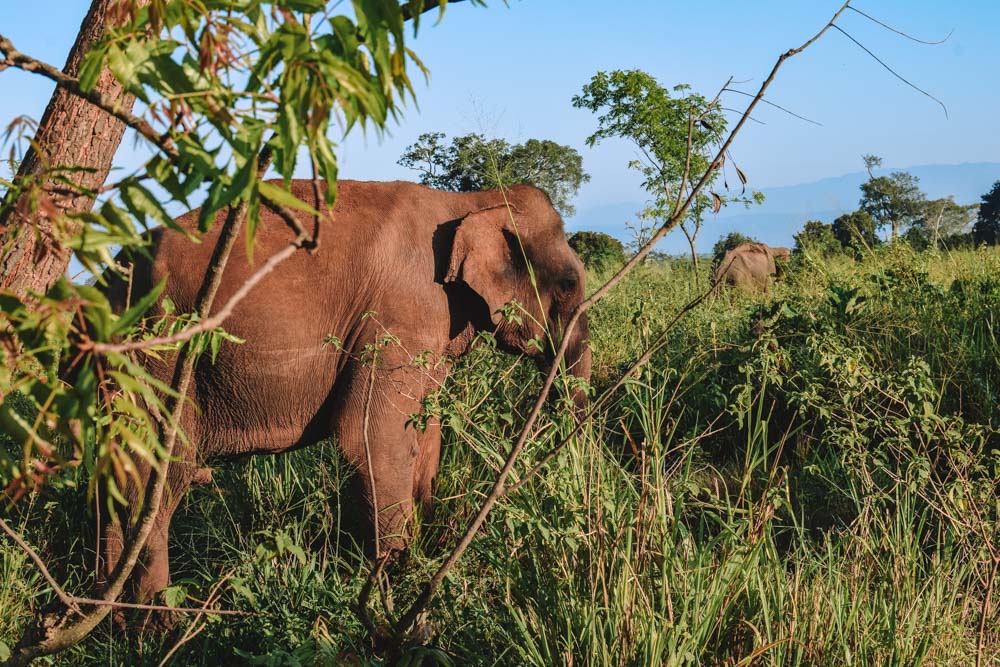
The elephants we spotted before even entering Udawalawe National Park
With so many elephants in a relatively small space, it’s the place everyone goes to if they want to be “guaranteed” to spot elephants.
Obviously you can never have 100% certainty when it comes to wild animals, but at Udawalawe it’s pretty much guaranteed that you will see elephants.
The best time to visit Udawalawe National Park for a safari is either at 7AM or 6PM. Early in the morning or at sunset is when the animals come out, during the day it’s too hot and they’ll be sheltering somewhere in the shade.

Exploring Udawalawe National Park during our elephant safari in Sri Lanka
Getting to Udawalawe National Park
Udawalawe National Park is 165km from Colombo, in the southern regions of Sri Lanka. The easiest way to get there is either by hiring a car and driver or with an organised tour.
Most people travel to Udawalawe from either the hill town of Ella or the southern coast, such as Mirissa and Weligama. You can also get a bus from any of these towns, they might just take a little longer than a private car.
We hired a car with driver to take us from Ella to Udawalawe, wait for us while we did the safari and then drive on to Mirissa for 11,000 LKR.
The total travel time was around 4 hours (2 hours from Ella to Udawalawe and then 2 hours from Udawalawe to Mirissa).
Sri Lanka elephant safari prices
One thing to note about doing an elephant safari at Udawalawe National Park is that there are separate fees for the jeep rental and the park entrance.
Some organised tours might include both, but make sure that is the case before booking so you don’t get any surprises on the day!
We organised our Udawalawe safari through our hostel in Ella and ended up paying 11,000 LKR for a private safari for two. The breakdown was 3,000 LKR for the private jeep and 8,000 LKR of park entrance fees.
The jeep could sit 6-8 people. If we had more friends to split the car with the cost would have worked out a little cheaper.
However the bulk of the expense is the park entrance fee, which is fixed at 15 USD per foreign adult. Comparatively the private jeep rental was fairly cheap.
If you’re travelling solo however it would add up to be quite expensive, joining a group safari would be the easiest and cheapest option.

The first elephant we saw during our safari in Udawalawe National Park, Sri Lanka
Organising & booking your Udawalawe safari
There are two main ways to arrange your elephant safari in Sri Lanka. You can arrange it with your accommodation once you arrive, or you can book online beforehand .
We personally found it very easy to arrange it directly in Ella, but if you prefer to have everything arranged before you arrive, here are some tours you can book that have good reviews online:
- Udawalawe National Park Safari Tour
- Udawalawe National Park Safari from Mirissa
- Elephant Safari in Udawalawe National Park from Bentota

Elephants in Udawalawe National Park, Sri Lanka
Our experience & what to expect at Udawalawe National Park
We set off from Ella at 5AM and were pretty knackered. We slept in the car and arrived at Udawalawe around 6AM, to find loads of jeeps and cars already parked there waiting for the park to open.
We quickly found our driver and changed cars for the safari. We joined the queue of jeeps waiting for the park to open.
We were in awe to see our first elephant before even entering in the park! We were on the road to enter the park, waiting in the jeep when an elephant just strolled up and started munching on some leaves just off the side of the road.
It was a great start to our Sri Lankan elephant safari!

My friend Hanna taking pictures of the elephants in Udawalawe National Park
Once we drove through the gate we had to pay the park entrance fees. We queued with our driver and paid 8,000 LKR for two people. After a quick toilet stop, we were ready to hit the road!
We spent 2-3 hours inside Udawalawe National Park, driving around and searching for elephants. The driving can get quite bumpy but we had the whole jeep just for us two, which was very convenient.
Even if it was so early in the morning the sun got very hot, it was nice having the whole jeep to ourselves so we could seat hop and always be in the shade.
It was also great being able to move around and get closer to the elephants without having strangers in the way.

Elephant safari in Udawalawe National Park
We saw so many elephants that I was in a constant state of wonder for the whole safari. We saw so many elephants, often in big groups and with baby elephants with them too.
Most of the time the elephants are just chilling on the side of the roads, munching away, unfazed by the presence of jeeps and people looking at them. They just get on with their business and ignore the jeeps.
One thing to note is that the jeep drivers are in constant walkie-talkie contact with each other. As soon as one driver spots elephants, all the other jeeps rush there to get a good spot close to the elephants.

Some of the buffalos we saw in Udawalawe National Park
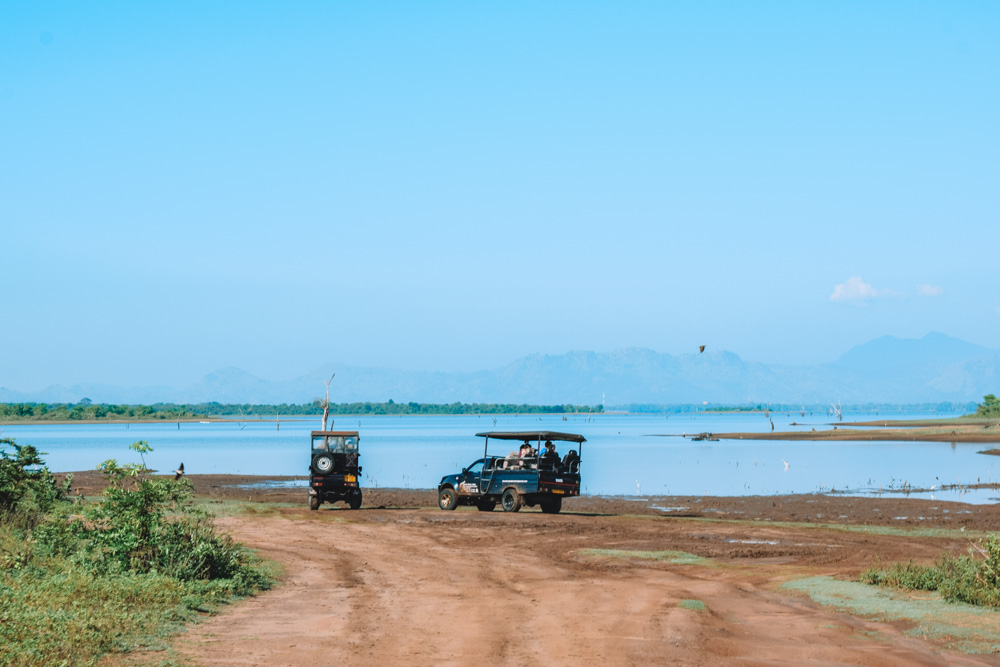
Jeeps in Udawalawe National Park
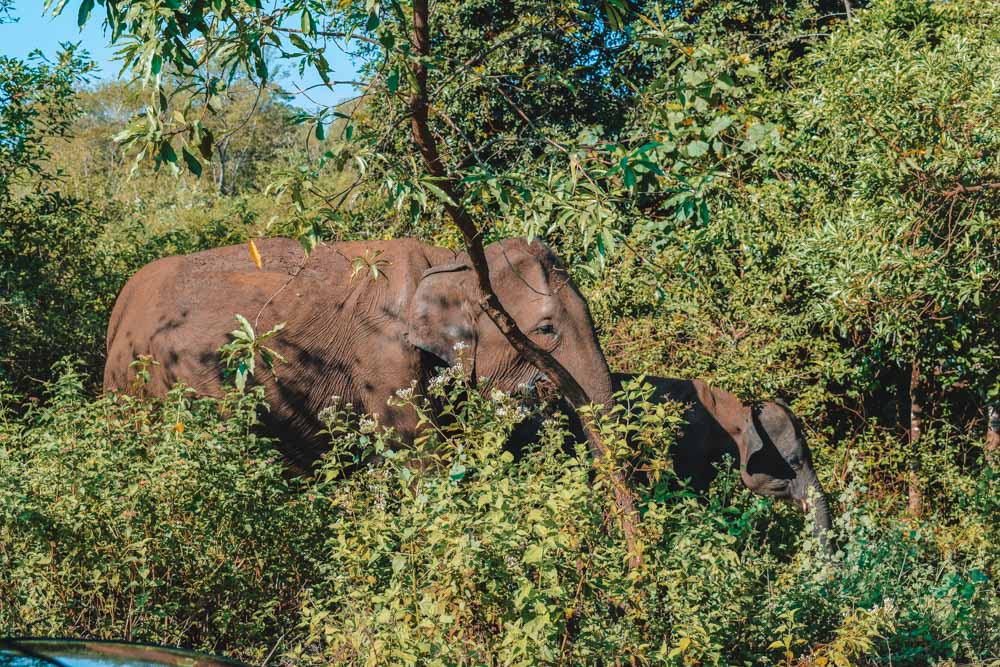
Elephants in Udawalawe National Park
This racing around the park chasing the elephants felt a bit weird at times. While the elephants are “wild” and free they’re obviously very used to seeing people.
Still, when compared to places that let you ride elephants or who keep them in chains, it’s still a much better and more ethical elephant encounter.
Besides elephants we also saw crocodiles, buffalos and pumbas, as well as lots of different types of birds. Once the safari was over we met up again with our driver outside the park and drove on to Mirissa.
Click here to book your Udawalawe National Park safari!

A giant asian water monitor we saw in Udawalawe National Park
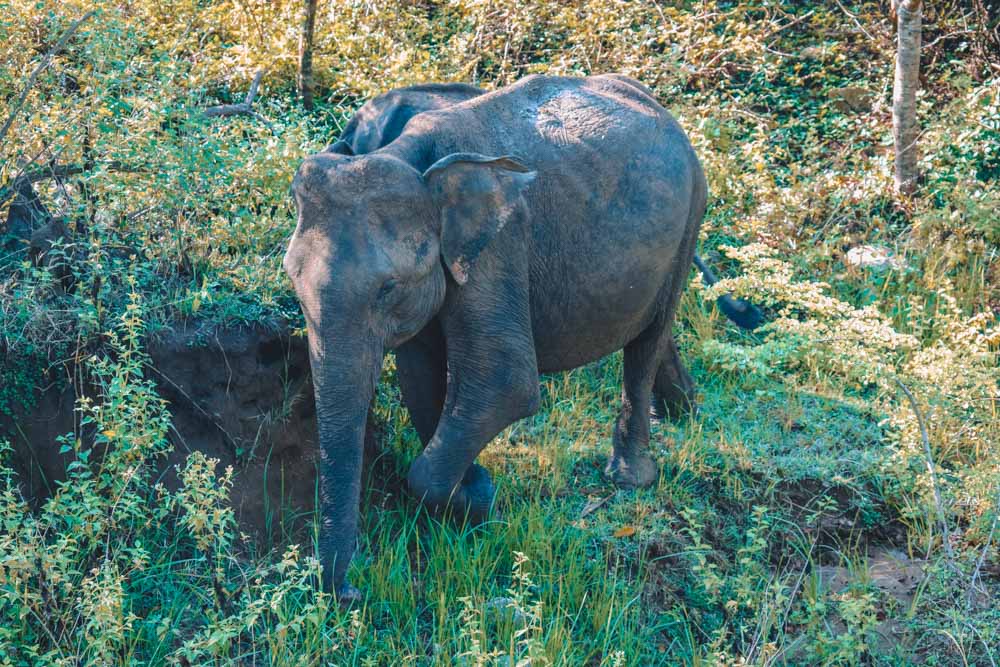
An adorable young elephant we saw in Sri Lanka
Where to stay for the best Sri Lanka elephant safari
The best places to stay to visit Udawalawe National Park ultimately depend on how much time you have in Sri Lanka. We personally did our safari on the road from Ella to Mirissa.
This was the perfect arrangement for us since it fit our schedule, and it avoided us the long car journeys that you would have to if you visit Udawalawe as a day trip.
If you have more time to stay in Udawalawe that would be awesome as you might be able to do more than one elephant safari. I have listed below some great accommodation options, wherever you choose to stay before or after your safari.

In Udawalawe
If you have the time and are looking for a unique experience, you should definitely stay in a glamping or safari lodge in Udawalawe. One of my friends stayed at Athgira River Camping and said he had an incredible time.
Click here to book your stay at Athgira River Camping!
We stayed in Ella the night before our safari and stayed at the Hangover Hostel . I personally loved it; it’s a sociable hostel with spacious rooms and lockers.
If you don’t want to stay in a hostel another great option in Ella is Mountain Heavens , they have an infinity pool overlooking the hills of Ella.
Click here to book your stay in Ella!
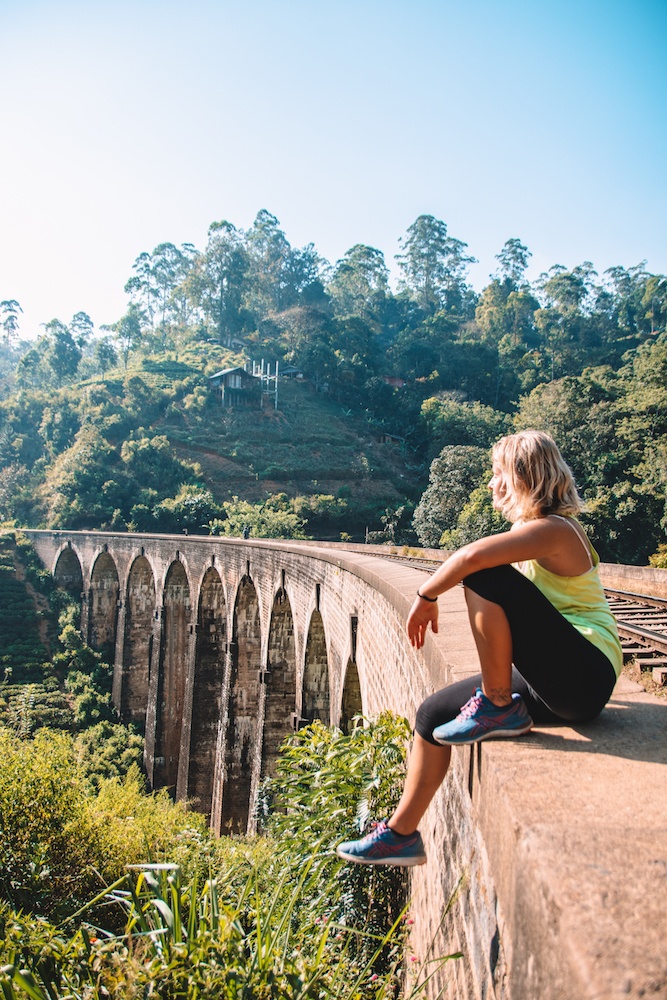
Nine Arch Bridge in Ella, Sri Lanka
You can also visit Udawalawe on a day trip from Mirissa.
After our safari we actually drove on to Mirissa after and stayed at the Hangover Hostel there. The hostel is beachfront, has airconditioned rooms with big lockers and big communal spaces.
If you prefer having your own place another great option in Mirissa is Paradise Beach Club , located right on the beach and with a lovely pool.
Click here to book your stay in Mirissa!

Sunset at the famous coconut hill in Mirissa, Sri Lanka
What to pack for your elephant safari in Sri Lanka
Besides the usual clothing and items you would find on any packing list for Asia , I’ve listed below some essential you will definitely want to bring on your elephant safari in Udawalawe National Park.
Hat – it can get very hot during your safari! Make sure to have a hat to shield your head from the sun.
Sunscreen – same as above, even if you do the safari very early in the morning you the Sri Lankan sun is still strong. Don’t ruin your safari by getting sunburnt.

A young elephant we spotted in Udawalawe
DSLR camera with a zoom lens – while the drivers often get quite close to the elephants, if you want to be able to capture beautiful photos of these magnificent animals you will want a proper DSLR camera with a zoom lens (make sure they’re compatible before buying a lens online!) That way you can snap photos of them up close, while being in the comfort of your jeep.
Water bottle – bring a reusable water bottle that you can fill up at the start of the safari, it gets very hot so you want to stay hydrated! I like the steel bottles because they keep your water cold.
Power bank – if you don’t have a DSLR don’t worry, you’ll still be able to capture great photos with your phone. However make sure to bring a power bank, you wouldn’t want your phone to die half way throughout the safari!

The elephant we saw before even entering Udawalawe National Park
Final thoughts on doing a elephant safari in Udawalawe National Park in Sri Lanka
Doing an elephant safari in Udawalawe National Park was one of my favourite things to do in Sri Lanka. Seeing these magnificent animals in the wild was an awe-inspiring experience, and I’m grateful to have had the opportunity.
I hope you find this guide useful in planning your visit to Udawalawe National Park and elephant safari in Sri Lanka. If you have any questions, just let me know in the comments below!
Looking for more Sri Lanka travel tips? Check out these guides:
- Ella Rock Hike – DIY without a guide!
- Everything you need to know about hiking Pidurangala Rock
- Discover Sri Lanka’s Insta-famous beach swing
- The most beautiful waterfall in Sri Lanka
- The most scenic train ride in Sri Lanka (and maybe the world?)
- Little Adam’s Peak sunrise hike
Enjoyed reading about Udawalawe National Park? Pin it!
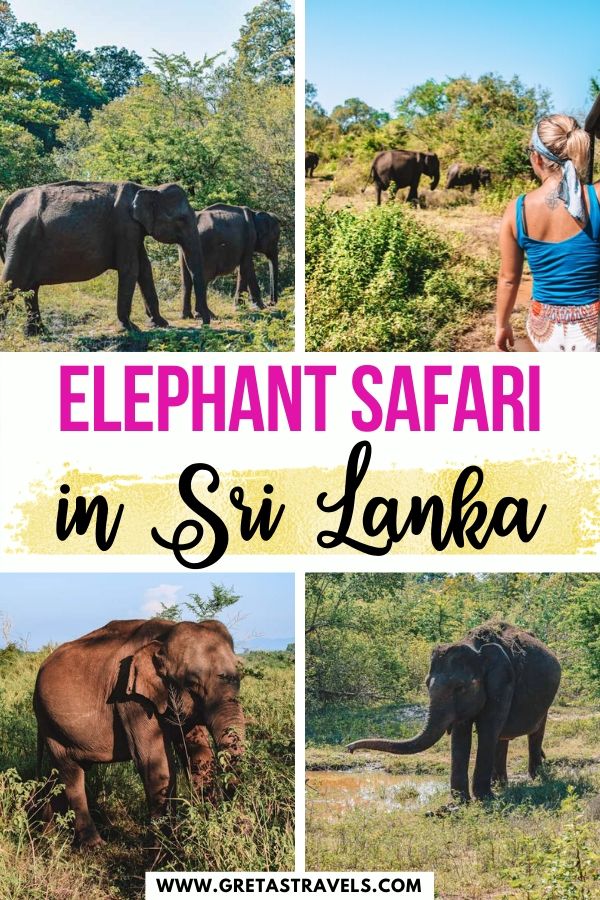
Corbett National Park
- +91-9012725777
- [email protected]

Corbett Elephant Safari:-
Elephant safaris in Jim Corbett National Park provide a unique and immersive way to explore the wilderness and spot wildlife in this iconic Indian tiger reserve. During a Corbett Elephant Safari, visitors ride on the back of trained elephants, guided by experienced mahouts (elephant handlers). This method of safari allows for a quieter and less intrusive approach to observing wildlife, making it possible to get closer to animals in their natural habitat without causing disturbance. Visitors may have the opportunity to see a variety of wildlife, including Bengal tigers, leopards, elephants, deer, and numerous bird species. Elephant safaris typically operate in select zones of the park, and it’s advisable to book these safaris in advance to secure a spot and ensure an unforgettable wildlife encounter while adhering to ethical wildlife viewing practices.
Corbett Elephant Safari in Details:-
Location and Zones :
- Jim Corbett National Park is divided into different zones, and not all zones offer elephant safaris. The availability of elephant safaris varies depending on the zone.
- The Durgadevi, Dhikala, and Bijrani zones are some of the zones where elephant safaris are often conducted.
- To go on an elephant safari in Jim Corbett, you typically need to make advance reservations through the official website of the park or through authorized tour operators.
- Booking can be competitive, especially during the peak tourist season, so it’s advisable to plan and book well in advance.
- Elephant safaris usually take place in two shifts – one in the morning and one in the afternoon.
- The morning safari typically starts early, around 8:00 AM, while the afternoon safari begins around 4:00 PM.
- Actual timings may vary depending on the season and availability.
- The duration of an elephant safari can vary but is typically around 2 to 3 hours.
Group Size :
- Elephant safaris are conducted with a limited number of visitors on each elephant, usually 4 to 6 people.
Wildlife Sightings :
- Elephant safaris provide a unique vantage point for wildlife viewing, as the elevated platform of the elephant allows for close encounters with animals like tigers, leopards, deer, and various bird species.
- However, wildlife sightings are never guaranteed, as animals roam freely in their natural habitat.
Experience :
- Riding an elephant through the dense forests of Jim Corbett National Park is a thrilling and memorable experience.
- The trained mahouts (elephant handlers) guide the elephants through the jungle, enhancing your chances of spotting wildlife.
Rules and Regulations :
- Visitors must adhere to the rules and guidelines provided by the park authorities and elephant handlers to ensure safety and minimize disturbance to the wildlife.
Climate and Dress :
- Jim Corbett experiences varying weather conditions, so it’s important to dress appropriately for the season and check the weather forecast.
- Light and earth-toned clothing is recommended for blending in with the natural surroundings.
Ethical Wildlife Viewing :
- It’s crucial to maintain silence during the safari to avoid startling or disturbing the animals.
- Avoid any sudden movements or loud noises that may agitate the elephants.
Corbett Wildlife Safari

- Max People:- 6 / Jeep
- Time:- Morning & Evening ( 4 hours )
- Departure:- Ramnagar
- Zone:- Bijrani, Jhirna, Dhela , Durgadevi, Sitabani, Phato, Garjiya

- Price: Rs 1700/ Person
- Max People:- 16/ Canter
- Time:- Morning & Evening ( 5 hours )
- Zone:- Dhikala

- Max People:- 4 / Jeep
- Time:- 8AM to 5PM
- Zone:- Dhikuli - Road to River max 5 km tour

Corbett Zone

The Bijrani Zone is one of the popular safari zones within Corbett National Park, located in the state of Uttarakhand, India. The park is named after the legendary British hunter and conservationist, Jim Corbett. The Bijrani Zone is known for its diverse wildlife, lush vegetation, and beautiful landscapes, making it a sought-after destination for nature enthusiasts and wildlife photographers

The Jhirna Zone is another popular safari zone within Corbett National Park, located in the state of Uttarakhand, India. This zone is known for its open grasslands, diverse flora, and a wide variety of wildlife. The Jhirna Zone is unique because it remains open to visitors throughout the year, unlike some other zones that close during the monsoon season.

The Dhela Zone is known for its dense forest cover and varied wildlife. It’s home to various animal species, including tigers, elephants, deer, wild boars, and a wide range of bird species. The terrain features diverse landscapes, including forests, grasslands, and water bodies. The Dhela Zone offers morning and afternoon safari slots.

The Durgadevi Zone is one of the safari zones within Corbett National Park, situated in the state of Uttarakhand, India. This zone is known for its diverse flora and fauna, along with the scenic beauty of its landscapes.

Within Jim Corbett National Park is the famous shrine on the Koshi river bank, and the Kartik Poornima is the time of year when the temple sees the most significant number of pilgrims. Book a safari for jungle visit.

Phato Zone is one of the well-known zones where the love of wildlife and the pleasant feeling of nature will give good vibes. Tigers are the key animal to be found in Jim Corbett National Park.

Outside the Corbett Tiger Reserve lies a protected forest region known as the Sitabani. This region is open to the public and serves as the tiger reserve’s buffer zone.
This zone is known to be the largest and most loved place of the tourists. It offers them the golden chance to see endless animals with the fun and excitement.

The Pakhro zone is well-known for its many wild creatures, including elephants, tigers, and leopards. Around the reserve, the most common mode of transportation is a safari in a jeep.

Jim Corbett National Park, located in the state of Uttarakhand, India, is one of the oldest and most renowned national parks in the country.
Useful Links
Address & contact details.
Address: Aasthan Mall Lakhanpur Chungi (Near bharat Petrol Pump) Ramnagar Dist Nainital, Uttarakhand – 244715 Jim Corbett National Park
©2023 Designed by BS Website Design
latest in World News

Vatican says transgender surgeries defy God, surrogacy defies...

At least 94 dead in African nation after unlicensed ferry boat...

Who are the Hamas leaders exterminated by the IDF six months into...

10,000 miles and 352 days later, endurance athlete reaches his...

Ex-Mass. city councilor who fled US over child porn charge...

Desperate Zelensky warns 'Ukraine will lose the war' if Congress...

Trump cries 'fake news' at report about plan to end Ukraine war...

IDF chief says Israel is prepared for 'multi-front war' with...
American tourist killed after elephant rammed truck on african safari seen smiling in photos before attack.
- View Author Archive
- Get author RSS feed
Thanks for contacting us. We've received your submission.
The American tourist killed by a charging bull elephant that flipped over their safari vehicle in Zambia over the weekend has been identified as an adventurous 79-year-old woman who wanted the trip to be her “last big adventure.”
Mattson, who was visiting from Minnesota, was pictured the day she was killed on the safari vehicle holding a flower, her grieving family told KSTP .
She was one of six tourists with the group Wilderness Zambia who were out on a game drive Saturday in Kafue National Park when they came under attack by the incensed animal .

Terrifying video footage shows the elephant chasing after the safari vehicle moments before it charged the group, tipping the truck over as the guide repeatedly yelled at the creature.
The passenger continues to record as the elephant flips the vehicle over.
Family told the outlet that the US Embassy contacted them about her death.

Loved ones described the 79-year-old as kind, adventurous and very active in her community.
“She had told us that this safari was going to be her last big adventure,” said her friend John Longabauth. “Because her birthday is in the summer — I think she was going to be 80, and she felt like she would start slowing down. To be honest, I don’t know if she’d slow down or not. But at least you wouldn’t be traveling as far, probably.”
Mattson split time between living in Minnesota and Arizona, her family said.
Her friends in Arizona held a memorial for her following her sudden death.
According to the Safari company, one other guest was hurt and taken to a private medical facility.
The four other tourists on the trip were treated for minor injuries after the violent outburst.
The horrifying incident unfolded at about 9:30 a.m. Saturday during a game drive through Kafue National Park, Wilderness Zambia CEO Keith Vincent said in a statement.
Kafue National Park’s management sent a helicopter to evacuate the victims.
“This is a tragic event and we extend our deepest condolences to the family of the guest who died. We are also, naturally, supporting those guests and the guide involved in this distressing incident,” Vincent said.

The group of tourists had been staying at the luxurious Lufupa Camp in the Kafue National Park, the largest game reserve in Africa.
The tour group is making arrangements for Mattson’s body to be returned to the US.
Police and other authorities are investigating the incident.
Share this article:

Advertisement

American tourist killed in tragic elephant attack on safari
Kafue, Zambia - An American tourist was killed and several others injured in an elephant attack at Kafue National Park in Zambia.
The video shows the elephant first chasing the vehicle and then, when the driver suddenly stops, starting to attack.
The ten-foot elephant ran straight towards the vehicle and did not appear to want to stop. The last thing the recording shows is the truck tipping over.
The national park has not yet commented on the incident, and it is still unclear exactly how the tourist died.
How did the tragic elephant attack happen?
Keith Vincent, the managing director of Wilderness Safaris, confirmed the death of the 80-year-old woman and said that another tourist was seriously injured and the other four were slightly injured.
According to him, the seriously injured man was taken to a private medical facility in South Africa, while the others were treated at a clinic.
"Our guides are all extremely well trained and experienced, but sadly, the terrain and vegetation was such that the guide's route became blocked," Vincent said of the terrible incident.
He reported that a helicopter had been sent to the accident and that both the police and the Department of National Parks & Wildlife were involved in the investigation of the incident.
He also assured that the deceased would be returned to the US.
"This is an extremely tragic event, and we extend our deepest condolences to the family of the guest who died," the Wilderness boss affirmed.

- International edition
- Australia edition
- Europe edition

US tourist killed after bull elephant toppled safari vehicle in Zambia
Four others were wounded in the attack at Kafue national park, in which the animal barreled into the side of a truck
An elderly US tourist was killed and four others hurt when an aggressive bull elephant charged and toppled their safari vehicle during a game drive in Zambia .
The attack at Kafue national park, in which the large pachyderm ran from a wooded area and barreled into the side of the truck, was captured on video and posted to social media by ABC News. It identified the tourist as 79-year-old Gail Mattson of Minnesota.
Keith Vincent, executive director of the safari operator Wilderness, told the network in a statement that the elephant’s charge was unexpected, and the driver had no opportunity to escape.
“Our guides are all extremely well trained and experienced, but sadly in this instance the terrain and vegetation was such that the guide’s route became blocked and he could not move the vehicle out of harm’s way quickly enough,” he said .
“This is a tragic event and we extend our deepest condolences to the family of the guest who died. We are also, naturally, supporting those guests and the guide involved in this distressing incident.”
Wildlife officials and local police say they are investigating Saturday’s incident, which took place in the national park about 220 miles north-west of Zambia’s capital, Lusaka. Covering almost 8,700 square miles, Kafue is the country’s oldest and largest national park, and is popular with tourists for its abundance and variety of birds and animals.
Wilderness said four other guests in the vehicle were treated for minor injuries.
Family members of Mattson, who also had a home in Arizona, told Minnesota’s KSTP News that she was “living life” on the game-watching holiday. Photographs of her in a safari truck clutching a flower, taken on the day of her death, accompanied the network’s report.
John Longabauth, a friend from Arizona, told the outlet he would miss her adventurous spirit. “She had told us that this safari was going to be her last big adventure,” he said. “Because her birthday is in the summer, she was going to be 80, she felt like she would start slowing down.”
Zambia’s neighbor Zimbabwe has expressed recent concern at a growing conflict between humans and elephants from a rising elephant population, especially one that is migrating more as the climate crisis disrupts animals’ access to food, water and cover, in Africa and around the world.
Most viewed
Elderly American tourist killed after elephant attacks vehicle in Zambia, reports say

An American tourist was killed after an "aggressive" bull elephant attacked the vehicle on March 30 during a tour in Zambia, according to media reports.
The tourist, identified only as an 80-year-old American woman, was injured when an "aggressive" elephant charged a vehicle carrying six guests and a guide in Kafue National Park in Zambia, according to a statement provided to multiple outlets including NBC News and People . She was part of a group staying at the Lufupa Camp and had gone out for a photography tour.
Zambia is a landlocked country located in southern Africa, bordered by countries including Zimbabwe, Democratic Republic of Congo and Tanzania.
Another woman who was injured was taken to a private hospital in South Africa, conservation and safari company Wilderness told multiple outlets. Four other people also received treatment for minor injuries.
Video shared on social media by ABC News shows the moment the elephant charged, with images showing later that the vehicle had been flipped on its side.
"The six guests were on the game drive when the vehicle was unexpectedly charged by the bull elephant," Keith Vincent, Wilderness' chief executive officer, said in a statement to ABC News. He added that the safari guide's vehicle was "blocked" by the terrain at the time of the attack.
The woman's body will be returned to her family in the U.S., Wilderness said in the statement to media.
USA TODAY has contacted Zambia police and Wilderness for more information.
Elephant Attack On Safari Leaves Elderly American Tourist Dead, Others Injured—What We Know
- Share to Facebook
- Share to Twitter
- Share to Linkedin
An 80-year-old American woman died after a bull elephant “unexpectedly charged” a vehicle on an expedition in Zambia on Saturday, safari operator Wilderness Destinations confirmed in a statement to Forbes Wednesday, an incident that was captured in a shocking video posted to social media.
The incident, which was widely shared on social media and is being investigated by authorities, occurred at 9:30 am local time Saturday at Kafue National Park in Zambia, according to Wilderness CEO Keith Vincent, who said the six guests were on a game drive when the vehicle was “unexpectedly charged” by the bull elephant.
Vincent said the company’s guides are “extremely well trained and experienced,” but the guide in Saturday’s accident did not have enough time to move the vehicle to safety, after the route became blocked from terrain and vegetation.
The 80-year-old American woman, who’s name has not been released, died in the incident while another woman was “taken to a private medical facility in South Africa” and four other guests were treated for minor injuries, according to the statement.
Local authorities and the U.S. Embassy in Lusaka are working to return the woman’s body to her family, according to the statement.
Kafue National Park did not immediately respond to Forbes’ requests for comment.
What We Don’t Know
The reason for the unexpected aggression has not been confirmed, but Wilderness is cooperating in the joint investigation from authorities and the Department of National Parks and Wildlife, according to the statement.
Key Background
While the cause for the aggression is currently unknown, bull elephants can become aggressive when experiencing “musth,” characterized by heightened aggression, increased testosterone excretion and temporal gland secretion, according to a 2022 report published in MDPI. It is a common phenomenon in healthy adult male elephants, according to the Asian Elephant Specialist Group, and can last for months. A similar incident involving a tour vehicle and a bull elephant confirmed to be experiencing “musth” occurred late last month in South Africa’s Pilanesberg National Park, according to ABC News , but no one was injured when the animal attempted to overturn the tour vehicle.
Further Reading
Videos show terrifying moment bull elephant lifts safari truck (ABC News)
Old Male Elephants: Don't Count Them Out (The New York Times)

- Editorial Standards
- Reprints & Permissions

- Bahasa Indonesia
- Eastern Europe
- Moscow Oblast
Elektrostal
Elektrostal Localisation : Country Russia , Oblast Moscow Oblast . Available Information : Geographical coordinates , Population, Area, Altitude, Weather and Hotel . Nearby cities and villages : Noginsk , Pavlovsky Posad and Staraya Kupavna .
Information
Find all the information of Elektrostal or click on the section of your choice in the left menu.
- Update data
Elektrostal Demography
Information on the people and the population of Elektrostal.
Elektrostal Geography
Geographic Information regarding City of Elektrostal .
Elektrostal Distance
Distance (in kilometers) between Elektrostal and the biggest cities of Russia.
Elektrostal Map
Locate simply the city of Elektrostal through the card, map and satellite image of the city.
Elektrostal Nearby cities and villages
Elektrostal weather.
Weather forecast for the next coming days and current time of Elektrostal.
Elektrostal Sunrise and sunset
Find below the times of sunrise and sunset calculated 7 days to Elektrostal.
Elektrostal Hotel
Our team has selected for you a list of hotel in Elektrostal classified by value for money. Book your hotel room at the best price.
Elektrostal Nearby
Below is a list of activities and point of interest in Elektrostal and its surroundings.
Elektrostal Page

- Information /Russian-Federation--Moscow-Oblast--Elektrostal#info
- Demography /Russian-Federation--Moscow-Oblast--Elektrostal#demo
- Geography /Russian-Federation--Moscow-Oblast--Elektrostal#geo
- Distance /Russian-Federation--Moscow-Oblast--Elektrostal#dist1
- Map /Russian-Federation--Moscow-Oblast--Elektrostal#map
- Nearby cities and villages /Russian-Federation--Moscow-Oblast--Elektrostal#dist2
- Weather /Russian-Federation--Moscow-Oblast--Elektrostal#weather
- Sunrise and sunset /Russian-Federation--Moscow-Oblast--Elektrostal#sun
- Hotel /Russian-Federation--Moscow-Oblast--Elektrostal#hotel
- Nearby /Russian-Federation--Moscow-Oblast--Elektrostal#around
- Page /Russian-Federation--Moscow-Oblast--Elektrostal#page
- Terms of Use
- Copyright © 2024 DB-City - All rights reserved
- Change Ad Consent Do not sell my data
Park Hotel Bogorodsk
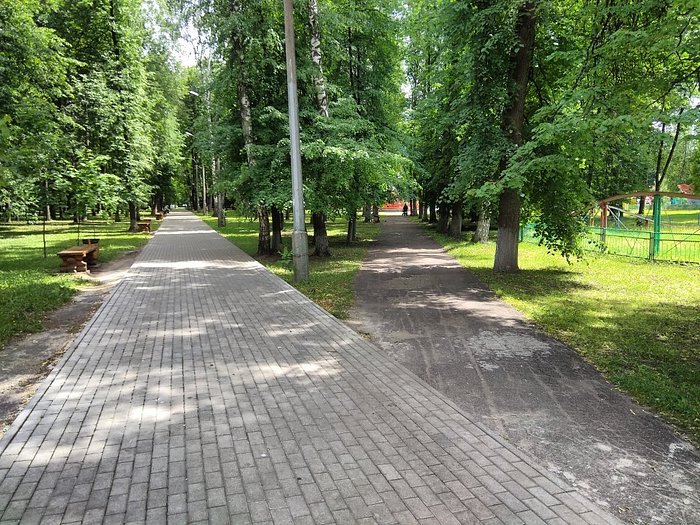
View prices for your travel dates
Finding an ideal hotel in Elektrostal does not have to be difficult. Welcome to Park Hotel Bogorodsk, a nice option for travellers like you.
Rooms at Park Hotel Bogorodsk provide a kitchenette, a refrigerator, and a seating area.
In addition, while staying at Park Hotel Bogorodsk guests have access to a concierge and room service. You can also enjoy a lounge.
Close to Statue of Lenin (1.5 mi), a popular Elektrostal landmark, Park Hotel Bogorodsk is a great destination for tourists.
Travellers looking for Italian restaurants can head to Apelsin or Dodo Pizza.
There is no shortage of things to do in the area: explore popular art museums such as Electrostal History and Art Museum.
Park Hotel Bogorodsk puts the best of Elektrostal at your fingertips, making your stay both relaxing and enjoyable.
Reviews We perform checks on reviews. Tripadvisor’s approach to reviews Before posting, each Tripadvisor review goes through an automated tracking system, which collects information, answering the following questions: how, what, where and when. If the system detects something that potentially contradicts our community guidelines , the review is not published. When the system detects a problem, a review may be automatically rejected, sent to the reviewer for validation, or manually reviewed by our team of content specialists, who work 24/7 to maintain the quality of the reviews on our site. Our team checks each review posted on the site disputed by our community as not meeting our community guidelines . Learn more about our review moderation.
- Excellent 0
- Very Good 0
- English ( 0 )
Own or manage this property? Claim your listing for free to respond to reviews, update your profile and much more.
PARK HOTEL BOGORODSK - Reviews, Photos (Elektrostal, Russia)
American tourist, 80, killed by charging elephant during safari tour at Kafue National Park in Zambia
A terrifying video captured the moment a bull elephant chased down and attacked a safari group, tipping over their vehicle.
Wednesday 3 April 2024 21:03, UK
Please use Chrome browser for a more accessible video player
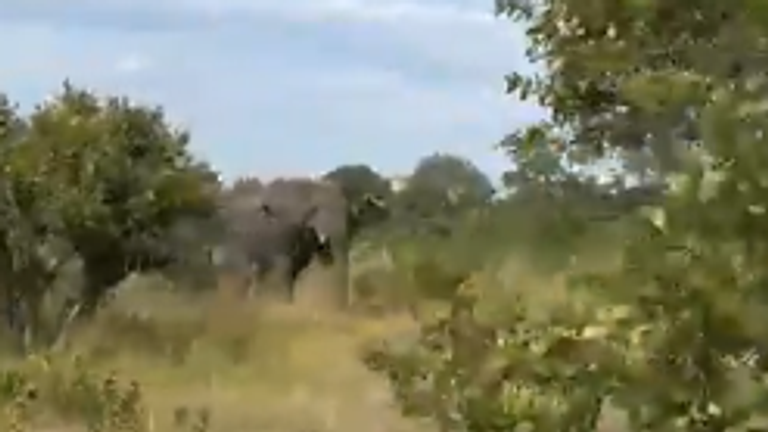
An 80-year-old American tourist was killed by a bull elephant when the safari tour group she was part of was charged at by the animal.
Another female guest was also injured in the incident that took place in the Kafue National Park, Zambia .
The group of six guests and a guide had been on a safari from Lufupa Camp, when around 9.30am local time on Saturday 30 March, their vehicle was "unexpectedly charged" by the animal.
A video captured the terrifying moment the elephant chased down the tour group.
The group's vehicle was driving through the national park as the elephant could be seen closing in on them.
The vehicle came to a stop and in the moments before the elephant knocked it over, the guide could be heard shouting "hey, hey, hey, hey, hey, hey!"

Keep up with all the latest news from the UK and around the world by following Sky News
Be the first to get Breaking News
Install the Sky News app for free

People were heard screaming during the attack.
More on Animals

'My heart is broken': Ex-paratrooper Chris Lewis pays tribute to dog who joined 17,000-mile trek around UK's coastline

US company hoping to bring back the dodo and the mammoth - but here's why it won't be like Jurassic Park

Inside the ancient city where thousands of monkeys look like they're running the show
Related Topics:
The second guest who suffered an injury was rushed to a private medical facility, while the other four guests received treatment for minor injuries.
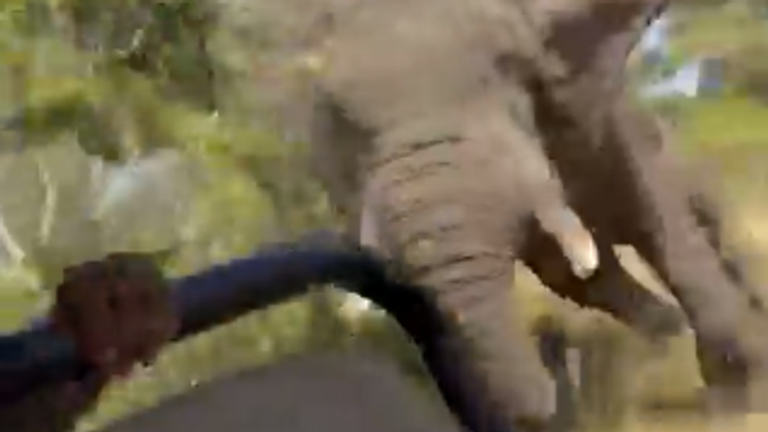
Read more from Sky News: Videos capture moment Taiwan earthquake struck Twelve-year-old suspected school killer 'had been bullied' Ex-Spanish football boss arrested at airport
Keith Vincent, Wilderness chief executive officer, said: "This is a tragic event and we extend our deepest condolences to the family of the guest who died. We are also, naturally, supporting those guests and the guide involved in this distressing incident."
Mr Vincent added the vehicle had stopped because "sadly in this instance the terrain and vegetation was such that the guide's route became blocked and he could not move the vehicle out of harm's way quickly enough".
Related Topics
trek 7.1 fx tire size

Trek 7.1 FX Review
Trek 7.1 FX is one of Trek’s best selling models. For £350- £375, you get a lot of features for your money which will appeal to a broad spectrum of commuting cyclists.
It’s not surprising why it is so popular. For most commuters and newbie cyclists sticking to roads, this bike does pretty much everything you need. It is reliable, solid and gives a good riding experience without any expensive extravagances.

It comes with 21 gears, and a very low ratio for getting up steep hills. Some may find the top gear of 48*14 a little on the slow side. You have to maintain a pretty high cadence to get over 25mph.
But, I doubt most people buying this will be worried at a lack of high end speed. If you are, you’re probably buying the wrong bike, and should look at a cheap road bike.
On the downside, the bike is a little heavy and rigid. If you’re riding over rough terrain like a canal path, your hands will certainly start to feel the vibrations on these minimal handlebar grips Despite the 35″ tyres, even riding around Leeds city centre I thought it a little tough.
If you can upgrade to the next FX model like the Trek 7.2 Fx – you get a lighter weight frame and more cushioning in the handlebars.
As I am used to riding stiff road bikes, this rigidity isn’t a big disadvantage to me, but, if real comfort is important, you may want to look at other hybrid bikes with suspension and a more forgiving set up.
On the plus side of comfort, I thought the Bontrager SSR saddle was excellent. Lovely shape and padding make it really quite comfortable. Gears within easy reach.
The gears are easy to use. Not instantaneous, but good enough given it is based on the lower end of the Shimano scale. You need to think ahead to get a burst of speed from lights, but, I was quite happy with the Shimano gears clicking away.
The brakes are Tektro lever pull – quite a common option for this type of hybrid bike. They offer reasonable, if unspectacular performance. Again an upgrade to disc brakes offers a significant improvement.
Pretty good. The set up is closer to road bike than mountain bike. Though the position can be adjusted with the riser bar. It felt nimble enough riding around town. Again solid and reliable rather than cutting edge.
Comes with mudguard and pannier holes, that you can add onto if you want. For overall commuting, the Trek 7.1 FX is a good all rounder. Fast enough to outperform thicker mountain bike style bikes, but with a greater stability to more aggressive road bikes.
Puncture Protection
Bontrager tyres. Uncertain of how these compare over time. There are better puncture resistance tyres on the market, which can always be added to.
This best-selling hybrid bike is popular with good reason. Trek know what a typical hybrid bike buyer is looking for. It gives very solid performance, though as someone who has ridden many different bikes, it does leave you dreaming of upgrading to get better features.
Trek bikes come in a variety of sizing so will fit most riders. There is also a women’s version with step through frame.
Who Would This Bike suit?
It would suit someone on a very strict budget of keeping the price down to below £350. If you’re the kind of bike rider looking for something special and a bit of zip, you will have to save more money. But, if you want a solid hybrid bike with minimum of fuss, then you can’t go too wrong with the Trek 7.1 FX.
Note: it wouldn’t be a great buy for any substantial off-road riding because the rigidity make for an unforgiving ride.
- Trek 7.1 FX 2015 at Evans Cycles
- Trek Hybrid Bikes at Evans Cycles
- Trek 7.1 FX at Trek.com
Trek FX 7.1 2015 model
Frame: FX Alpha Silver Aluminium, DuoTrap S compatible, rack and mudguard mounts Fork: High-tensile steel w/lowrider mounts, CLIX dropouts Front Derailleur: Shimano Tourney Rear Derailleur: Shimano Acera M360 Number of Gears: 21 Shifters: Shimano Altus EF51, 8 speed Chainset: Shimano M131 Chainrings: 48/38/28T Bottom Bracket: Sealed cartridge Cassette: SunRace Freewheel 14-34, 7 speed Chain: KMC Z51 Pedals: Wellgo nylon platform Brakeset: Tektro alloy linear-pull brakes, Shimano Altus levers Handlebars: Bontrager Riser, steel, 30mm rise Stem: Bontrager Approved, 25.4mm, 25 degree, quill Grips: Bontrager Satellite Rims: Bontrager AT-550 36-hole Hubs Formula FM21 alloy Tyres, 700×35c Saddle: Bontrager SSR Seatpost:Bontrager SSR, 27.2mm, 12mm offset
Related pages
- Trek 7.1 FX 2015 – £375 at Evans Cycles
- Best Hybrid Bikes
2 thoughts on “Trek 7.1 FX Review”
- Pingback: Best hybrid bikes -
350 Pounds would be a reasonable price by the way, I really like the design but most of all the high quality of course.
Leave a Comment Cancel reply
- off.road.cc
- Dealclincher
- Fantasy Cycling
Support road.cc
Like this site? Help us to make it better.
- Sportive and endurance bikes
- Gravel and adventure bikes
- Urban and hybrid bikes
- Touring bikes
- Cyclocross bikes
- Electric bikes
- Folding bikes
- Fixed & singlespeed bikes
- Children's bikes
- Time trial bikes
- Accessories - misc
- Computer mounts
- Bike bags & cases
- Bottle cages
- Child seats
- Lights - front
- Lights - rear
- Lights - sets
- Pumps & CO2 inflators
- Puncture kits
- Reflectives
- Smart watches
- Stands and racks
- Arm & leg warmers
- Base layers
- Gloves - full finger
- Gloves - mitts
- Jerseys - casual
- Jerseys - long sleeve
- Jerseys - short sleeve
- Shorts & 3/4s
- Tights & longs
- Bar tape & grips
- Bottom brackets
- Brake & gear cables
- Brake & STI levers
- Brake pads & spares
- Cassettes & freewheels
- Chainsets & chainrings
- Derailleurs - front
- Derailleurs - rear
- Gear levers & shifters
- Handlebars & extensions
- Inner tubes
- Quick releases & skewers
- Energy & recovery bars
- Energy & recovery drinks
- Energy & recovery gels
- Heart rate monitors
- Hydration products
- Hydration systems
- Indoor trainers
- Power measurement
- Skincare & embrocation
- Training - misc
- Cleaning products
- Lubrication
- Tools - multitools
- Tools - Portable
- Tools - workshop
- Books, Maps & DVDs
- Camping and outdoor equipment
- Gifts & misc

First Published May 29, 2009
At road.cc every product is thoroughly tested for as long as it takes to get a proper insight into how well it works. Our reviewers are experienced cyclists that we trust to be objective. While we strive to ensure that opinions expressed are backed up by facts, reviews are by their nature an informed opinion, not a definitive verdict. We don't intentionally try to break anything (except locks) but we do try to look for weak points in any design. The overall score is not just an average of the other scores: it reflects both a product's function and value – with value determined by how a product compares with items of similar spec, quality, and price.
Good scores are more common than bad, because fortunately good products are more common than bad.
- Exceptional
- Not so good
The 7.7FX is the one-from-the top Trek ‘bike path’ bike. They’ve designed it to be a do-it-all machine: recreation, transportation and exercise. It’s a road bike with an upright geometry – not an easy thing to deliver on – but as a package it's a good lightweight commuter, if a little upright for longer jaunts.
Trek 7.7 gallery
Trek have gone to a lot of trouble to make the upright position work, the two key features being the Isozone insert which is an elastomer dampener at the top of the seatstays (Trek are keen to point out it's not 'suspension'), and the Nebula Plus saddle with flexform – basically a pivot that allows the saddle to move in a slight arc along the line of the bike – which is specifically designed for the riding position of the FX series. These two, combined with the carbon fork and seatpost make for a comfy, road buzz free ride.
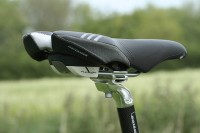
It works really well as a get around town commuter, just hop on and power away. The frame is stiff enough to transfer anything you put through the pedals in to forward speed. This is where the disadvantage of the upright position comes in though: once you are up to a decent speed (especially if you’ve been racing the roadies from the traffic lights, and this bike is particularly good at that) it’s not so easy to keep it up. The bike is so short – more so than some other hybrids – that the upright position makes you act as a very effective airbrake. I swapped the stock stem out for a 130mm unit just to get a little bit lower.
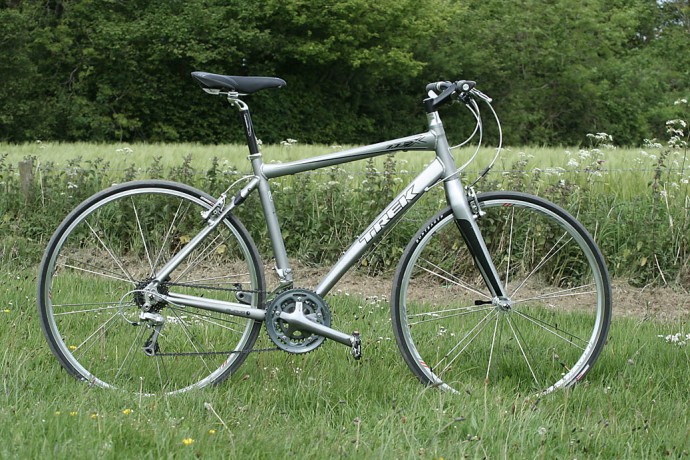
The Isozone dampener works a treat to make the ride comfortable, but once you load it up you do notice there’s a bit of wobble. That wobble turned into a scary shimmy descending with luggage at over 30mph at one point, which is not great. I used the bike quite a lot with my son in a child seat and had to be very careful to keep the speed down coming down hills. It's much better when it's unloaded at the back.
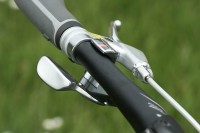
The drivetrain works really well and I loved the 105 flat bar controls, they give a very positive shift (clunk!). You can trim the front mech (two positions) in the granny and middle rings which is helpful, but I did get a bit confused with the gear indicator for the rear block. This doesn’t seem to have changed from the nine speed mountain biking kit, yet it has to fit 10 gears in what’s designed for three blocks of three: the lowest gear didn’t match up with the lowest position on the indicator. Consequently I found myself looking at the block to know what gear I was in. The bike is sprightly up the climbs – it's better going up than down – but felt a bit overgeared on the steep stuff, especially with a child seat or luggage on the back.

The brakes are a bit of a let down compared to the quality feel of the shifters and drivetrain. They’re perfectly functional and will stop you in no distance at all but they feel a bit cheap and modulation isn't good. Maybe this is where Trek made a saving to fit some of the other kit in, but performance-wise they don't match up to the rest of the spec.
I liked the wheels, they coped admirably with me and my son, even on roughstuff. I particularly liked the underrated (in my opinion) Bonty race lite hardcase tyres. They roll well and feel more racy then you’d expect from a 28. They are good in the wet and above all they are very puncture resistant.
The Trek 7.7FX is comfortable and great fun to ride. Thanks to its light weight and elements of road bike geometry it’s quick off the mark but its upright position is not ideal for bigger rides. The 105 controls are great and it’s a nippy around town bike, but it's not really set up for longer distances.
If you're thinking of buying this product using a cashback deal why not use the road.cc Top Cashback page and get some top cashback while helping to support your favourite independent cycling website
road.cc test report
Make and model: Trek 7.7FX
Size tested: 20"
About the bike
State the frame and fork material and method of construction. List the components used to build up the bike.
Frame: FX Alpha Black Aluminum w/IsoZone monostay
Fork: Bontrager Nebula, carbon
Wheels: Bontrager Race
Tires: Bontrager Race Lite Hardcase, 700x28c; 60tpi
Shifters: Shimano R770, 10 speed
Front Derailleur: Shimano R773
Rear Derailleur: Shimano Ultegra
Crank: Shimano 105 50/39/30
Cassette: Shimano 105 12-27, 10 speed
Pedals: Wellgo single sided, clipless
Saddle: Bontrager Nebula Plus
Seat Post: Bontrager Nebula Elite, carbon
Handlebars: Bontrager Race, 25mm rise, 31.8mm (15.5, 17.5": 0mm rise)
Stem: Bontrager Nebula, 12 degree, 31.8mm
Headset: Aheadset Slimstak w/cartridge bearings, sealed, alloy
Brakeset: Tektro RX 1.0 w/Tektro alloy levers
Tell us what the bike is for, and who it's aimed at. What do the manufacturers say about it? How does that compare to your own feelings about the bike?
Trek state: “Designed to fit every riding need, the FX Platform is the all-day, every day ride for recreation, transportation or exercise. A versatile, upright riding position coupled with features like Flex Form and IsoZone technology provide optimal comfort for going the distance on the bike path or burning through a quick workout.”
It certainly is a very nice, very comfortable, and really quite nippy bike for recreational riding on the road, bike paths or trails.
Transportation works to a certain degree: because of the IsoZone damping widget at the top of the seatstays, it’s never going to be the stablest load carrier.
Going the distance? It depends what you call distance. 10-20 miles and I’m with Trek. Anything longer than that, especially in sub-optimal weather, and I’d want something less upright.
Similarly, it depends what you want out of a workout. It’s a really nice bike that you’ll want to ride, so I reckon it fits the bill. I don’t think anybody would mistake it for a machine that’ll make you quicker at your next time trial.
Frame and fork
Tell us about the build quality and finish of the frame and fork?
The frame and fork both seem of a decent quality. Normal use during the test period didn’t cause any blemishes on the finish. Although I don’t like the looks partly painted carbon fork, the finish quality seems decent.
Tell us about the materials used in the frame and fork?
The Trek 7.7FX’s frame is made from 6000-series aluminium, with the fork made of carbon. The clever bit is this IsoZone insert that sits just above the rear V-brake, where the seatstays join together into a monostay. Trek reckon they’ve “killed vibration in the range a rider feels most (between 40-50 Hz), a rate of twice that of any other system currently on the market.” I can’t vouch for the numbers, but the bike certainly feels comfortable because of it.
Tell us about the geometry of the frame and fork?
My experience of the geometry is pretty much as Trek describe it: practically a road bike, but with an upright riding position. It felt really quite short with the stock stem for a bike that was evidently my size in every other dimension. Swapping out the stem to a 130mm road one sorted this out to a certain extent for me.
Where I noticed the road bike geometry most is that the seat tube angle seemed almost racing bike steep. The consequence of this is that your sitting relatively far forward, with your weight pretty close to the bottom bracket, which is really good for putting the power down.
How was the bike in terms of height and reach? How did it compare to other bikes of the same stated size?
Riding the bike
Was the bike comfortable to ride? Tell us how you felt about the ride quality.
The carbon fork, Isozone insert and the carbon seatpost certainly soak up the road buzz. I found the saddle extremely comfortable, especially so for the upright riding position (which is what the saddle is specifically designed for).
Did the bike feel stiff in the right places? Did any part of the bike feel too stiff or too felxible?
The bike has the right stiffness for what it’s designed for. Power transfer is good, but it’s flexible enough to be comfortable.
How did the bike transfer power? Did it feel efficient?
Power transfer is exceptional on this bike, put your foot down at the traffic light and you’ll have no problem keeping up with the roadies. Because of it’s upright position, you’ll have to work hard to keep that speed going though.
Was there any toe-clip overlap with the front wheel? If so, was it a problem?
There was no overlap.
How would you describe the steering? Was it lively, neutral or unresponsive? neutral
Tell us some more about the handling. How did the bike feel overall? Did it do particular things well or badly?
Unloaded, the bike feels stable and handles very well. As soon as you add a rack with any significant weight, you can feel that the bike was not really designed for this purpose.
Commuting with a couple of small panniers full of clothes, you notice that the back-end starts to wobble a bit. More worrying is that descending with this type of load (around the 10kg mark) the bike starts shimmying around 30-35mph.
Similarly, with a 2.5yr old boy on the back, you have to be careful. Once you’re cruising it’s fine, but manoeuvring at low speeds can be tricky. I wouldn’t even dream of taking the bike up to 35mph with my son on the back.
The drivetrain
Wheels and tyres, your verdict.
Did you enjoy riding the bike? Yes
Would you consider buying the bike? Not really for me
Would you recommend the bike to a friend? Possibly, depends what they are looking for.
Overall rating: 7 /10
About the tester
Age: 32 Height: 1.78m Weight: 76kg
I usually ride: All of them! My best bike is: Cervelo Dual
I've been riding for: Over 20 years I ride: Every day I would class myself as: Expert
I regularly do the following types of riding: time trialling, commuting, touring, club rides, fixed/singlespeed, Audax
Help us to fund our site
We’ve noticed you’re using an ad blocker. If you like road.cc, but you don’t like ads, please consider subscribing to the site to support us directly. As a subscriber you can read road.cc ad-free, from as little as £1.99.
If you don’t want to subscribe, please turn your ad blocker off. The revenue from adverts helps to fund our site.
Help us to bring you the best cycling content
If you’ve enjoyed this article, then please consider subscribing to road.cc from as little as £1.99. Our mission is to bring you all the news that’s relevant to you as a cyclist, independent reviews, impartial buying advice and more. Your subscription will help us to do more.
Add new comment

Greet the authors of the site. Want to express thanks for good work.Your article very useful and interesting.
- Log in or register to post comments
I love to ride on Trek 7.7FX. It’s really amazing and comfortable bike for riding. Its brakes are a tad of a let down evaluated to the superiority feel of the shifters and drive teaches.
Latest Comments
What ? Did he drove off the rails or start in the cycle lane ?
Did the same for youngest. £15 for a wetsuit. Worth a punt imo. Also got a 65L rucksack for £30 so eldest can use it on DoE award. Think there is...
Ah, but he was in the cycle lane so it doesn't count!
This sounds a similar concept to a Cervelo Caledonia - any experiences on how they compare?
Thank you all for your comments on this. ...
More crap cycling infrastructure in Edinburgh, what a surprise, not!
They didn't investigate all crimes long before they recognised they weren't doing it. I have footage of gang crime, not interested either..
Lorry driver and a band causing this one...
Sure the OEM prices they pay are much cheaper, but given that a bike cost now as a groupset, every cost saving is welcome especially at lower spec...
Related Reviews
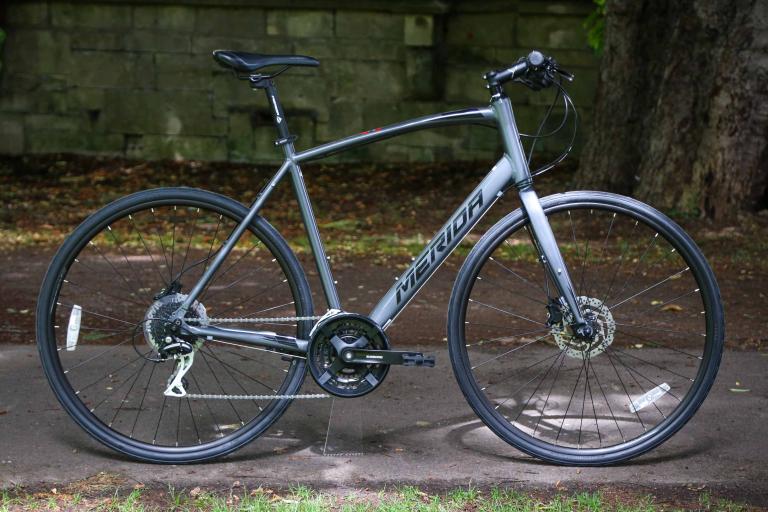
Merida Speeder 20D 2024
Entry-level commuter/leisure bike that's both practical and enjoyable to ride
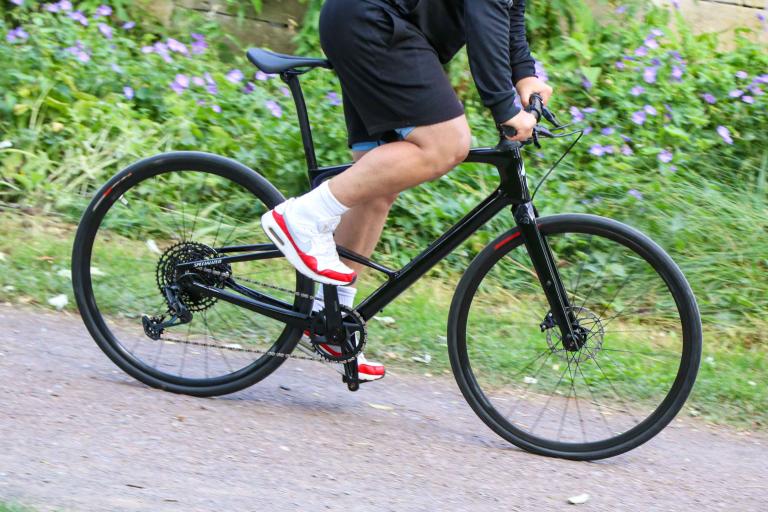
Specialized Sirrus 6.0 2023
Quirky but quick and comfortable, with tyre clearance allowing for some gravel action

Merida Crossway 300 2023
Dependable, friendly hybrid with comfort-boosting features and huge gear range, if a bit heavy
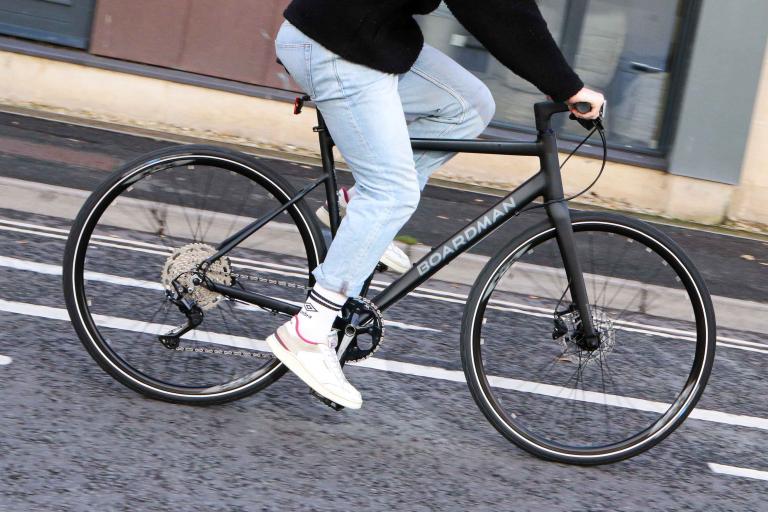
Boardman HYB 8.8
Exciting hybrid that offers more performance than you might expect, but it can feel a bit firm at times
- Specialized
- Bridge Bikeworks
- Brooklyn Bicycle Co.
- Bunch Bikes
- CYCLE OF GOOD
- DALLINGRIDGE
- Diamondback
- Eddy Merckx
- Electric Bike Company
- EVO Bicycles
- Fahrradmanufaktur
- Flyer by Radio Flyer
- iGO Electric
- Intense 951
- JupiterBike
- Lectric eBikes
- LeMond Bicycles
- Lightweight
- View all brands
- Pivot Cycles
- Qualisports
- Quintana Roo
- Rad Power Bikes
- Raleigh Electric
- Riese & Müller
- Rocky Mountain
- Schindelhauer
- State Bicycle Co.
- Surface 604
- Urban Arrow
- Van Nicholas
- VELO DE VILLE
- Vintage Electric
- Yeti Cycles
- YT Industries

Trek 7.7 FX
- AUS $ NZD $ USD $ CAD $ GBP £ EUR €
At a glance
Trek’s 7.7 FX delivers unparalleled versatility that rockets along roads, cruises along bike paths, and even hits dirt roads. Its carbon frame is light and nimble for effortless riding and great handling. The frame is graced with tubeless-ready Bontrager wheels, and a precision Shimano 20-speed drivetrain with wide-range gearing for cruising over the climbs. Quick-stopping Tektro brakes give you stopping power for the ride back down, and you’ve got a plush Bontrager seat and a great bar, stem, and seatpost as well. All your rides just got a lot more fun, and you just got a whole lot fitter.
Where To Buy

Specifications
- Frame Trek 400 Series OCLV carbon
- Fork Trek, carbon
- Hubs Front: aluminum; Rear: Formula
- Crank Shimano Tiagra
- Front Derailleur Shimano Tiagra
- Rear Derailleur Shimano Tiagra
- Shifters Shimano Tiagra
- Brakeset Aluminum dual-pivot
- Handlebar Bontrager Satellite Plus IsoZone
- Saddle Bontrager Evoke 1
- Stem Bontrager Blendr Elite
- Grips Bontrager Satellite IsoZone Elite
Q: How much is a 2016 Trek 7.7 FX?
A 2016 Trek 7.7 FX is typically priced around $1,890 USD when new. Be sure to shop around for the best price, and also look to the used market for a great deal.
Q: What size 2016 Trek 7.7 FX should I get?
No comments on this bike yet. Why not be the first?
Leave a Reply Cancel reply
Your email address will not be published. Required fields are marked *
Want more road bikes in your mailbox?
The latest on road bikes delivered straight to your mailbox.

More hybrid Bikes View All
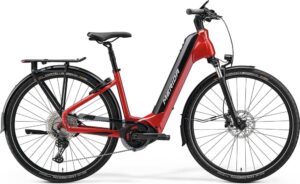
Merida eSPRESSO CITY EP8-EDITION EQ
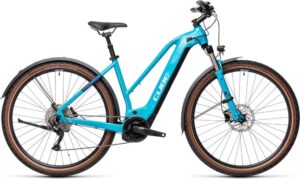
Cube NATURE HYBRID EXC 500 ALLROAD Trapeze
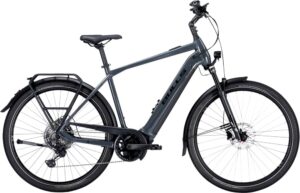
Bulls Cross Lite EVO 2 Schweiz Diamond
Deals view all, view all deals, recent posts view all.

What is Road Bike Database?
Whether you're a seasoned cyclist or just starting out, choosing the right road bike can…
Send Feedback
Have a suggestion? Looking for a bike that's not on Road Bike Database? Or perhaps you've spotted an error?
We'd love to hear from you. Let us know with the form below.
This website uses cookies to ensure you get the best experience possible. Learn more.
About Road Bike Database
Explore, search and compare thousands of the world’s best road bikes here on Road Bike Database.
Compare prices, components, reviews, images and more on current and past road bikes. You can even share reviews, comments and questions on road bikes. View and compare a huge selection of bikes from brands such as Cervélo , BMC , Trek , Specialized and more .
We strive to provide accurate and up-to-date information for road bikes on Road Bike Database. If you’ve spotted any issues, please let us know . We also include helpful tools, such as our frame size calculator, to assist you in choosing the right road bike. Bear in mind that these tools serve as a guide and simply provide a general indication. Refer to information provided by your bike manufacturer for the most applicable information for your bike.
Bikes By Brand
Bikes by year, bikes by riding style.
- Electric Road
- folding-bike
- general-road
- general-urban
- long-tail-cargo
Bikes By Wheel Size
Popular bikes.
- 2021 Trek Loft 7i Men's
- 2022 Serial 1 RUSH/CTY STEP-THRU
- 2022 Cannondale Topstone 2
- 2023 Canyon Pathlite:ON 8 SUV step-through
- 2023 Bianchi Aria e-Road 105 Di2
- 2023 VELO DE VILLE AEB 890 10 speed Shimano Cues
- 2022 Electra Loft 7i EQ Step-Over
Latest Bikes
- 2024 Riese & Müller Delite4 GT touring
- 2024 Riese & Müller Delite4 GT rohloff
- 2024 Riese & Müller Delite4 GT rohloff HS
- 2024 Riese & Müller Delite4 GT vario HS
- 2024 Riese & Müller Delite4 GT vario
- 2024 Riese & Müller Delite4 GT touring HS
- 2024 Riese & Müller Roadster4 Mixte vario HS


- ALL (67 Forums)
- WHEELS & TIRES
- SPECIALIZED
- CYCLOCROSS BIKES
- TIRES & WHEELS
Trek 7.7 FX Hybrid Bike

- USER REVIEWS
This is a 2012 FX 7.7 . Love the color . Very comfortable bike to ride . I am a 70 year old Snowbird that spends the winters in Tucson Az . Handles the climbs & rolling hills in Tucson Az The Shimano 105 components are well suited for this smooth riding bike . Fast , light & handles very well. The IsoZone Monostays absorbs the road bumps nicely as advertized. I put Schwalbe Ultrimo 28cc tires on for more comfort , they are slick & enhance the appearance & are fast . Also swapped out the pedals for Shimano Duro Ace . I have no more numbness in the hands with the Ergo Grips. I ride about 100KMS a week & wanted a fast comfortable flat bar , & this is it . In my opinion this bike is well worth the $.
very , very good bike . Difference in price compared to 7.6 definitly worth . Much lighter and much better components .
Similar Products Used:
other bikes : Specialized stumpjumper FSR '07 ; custom Trek 8000 '01 ; Time Edge first racebike
Frame is very light without being too stiff for long rides. Great components. 105 crank, cassette, and front dérailleur. Ultegra rear dérailleur. Handles very well.
I wish it had better brakes (e.g. XT instead of M431, or disc brakes would be nice too). When I put on my front brake while going downhill, the whole bike shakes. This doesn't happen with the rear brake. The 24-spoke wheels, while fast and light, do not seem very strong. My front wheel went out of true after hitting a pothole and I had to spend some time truing it back up. By contrast, my 36-spoke touring wheels on my Cannondale have never gone out of true despite taking far more abuse.
Bought the 2008 7.7 FX three months ago at the LBS for 1200 euros (about $1750) primarily for commuting to work 40 km/day. I actually wanted the Trek Portland, but they don't sell them outside the U.S., so I settled for the FX instead. At first, I was not too excited about the style. In fact, I thought it looked rather ugly. However, it had everything I needed to make it a worthy commuter and good hybrids are hard to find around here (most bike shops here only carry high-end road or mountain bikes with nothing in-between). I've since put 1600km (about 1000 miles) on the bike and I must say that I'm very pleased with it. It handles beautifully... smooth and fast. It's such a joy to ride that I even look forward to my commute in sub-zero temperatures. The bike weighs just under 10kg (about 22 lbs), so it's quite light for a hybrid.
First hybrid I've owned, although I've ridden road, mountain, and touring bikes for years.
Fantastic ride on pavement. I'm looking forward to testing it out on crushed limestone bike paths. I switched from 700 x 28 to 700 x32 tires to accomodate the trails better. My wife received her 7.7 a few months before me and was kicking my but on the trails. On the paved roads, I'm able to take the lead again and set a good pace. The components on this bike are incredible. It's also incredibly light in comparison to the hybids. Great bike for the money if you plan on doing lots of riding.
May want to avoid bike paths/trails that are too rough. This bike is more responsive/delicate than the hybids.
I received my new 2009 Trek FX 7.7 about a month ago and am absolutely thrilled with it. My wife has the same bike only the 2007 model. She has had her bike since September of 2008. Prior to the FX bikes, we both had Trek 7300 hybrids. Most our riding has been on crushed limestone and some paved bike trails. The Fx 7.7 is by far more efficient than the 7300 hybids (great climber, quicker acceleration and faster cruising speed). We will be planning some longer trips this spring summer and fall.
My wife and I moved up from the Trek 7300 hybrids to the FX 7.7 to icrease our ride efficiency. We are both over 50 and wanted to stay with a flat bar bike that could keep up with the road bikes and still negotiate bike paths that were decent condition.
The Shimno 105/Utegra setup provides for smoother shifting than the other fx bikes I've used. I like the 27 speed triple crank for its versitality as I live in a hilly area.
Glad I replaced my seat. Not necessarily a weakness but I replaced my 32cm tires for 25cm and notices the speed increase. If I tour with this bike, I'll use the 32cm tires.
I love this bike. I use it for exercise and for occassional commuting. At the same time I credibly hold my own among the race bikes during my weekly Rose Bowl laps. Buzz kill elastomers and carbon forks and seat post really dampen vibration. As I'm an older guy my flat bars don't produce any neck strain. If you want a reasonably fast but comfotable bike for fitness, this is the one.
Trek 7.2fx, 7.5fx,
Just a great overall Hybrid. Light, responsive, good on hills. Forgiving on off pavement.
Low on top end speed
Over 2000 miles ridden last year. Have noticed them on sale at the $1000 mark for left over new models in Jan/08.
Get the latest road bike reviews, news, race results, and much more by signing up for the Roadbikereview Newsletter
Hot Deals See All Hot Deals >>
Get the latest roadbike reviews, news, race results, and much more by signing up for the Roadbikereview Newsletter
- EDITORIAL REVIEWS
- CLASSIFIEDS
ABOUT ROADBIKEREVIEW
- TERMS OF USE
- PRIVACY POLICY
- ADVERTISING
VISIT US AT
© Copyright 2024 VerticalScope Inc. All rights reserved.

- Rider Notes
2016 Trek 7.1 FX

A 700c aluminum frame fitness bike with modest components and rim brakes. Compare the full range
For This Bike
View more similar bikes →
A bike with lower gearing will be easier to ride up steep hills, while a higher top end means it will pedal faster down hills.
Similar Bikes
(descending)
Add custom gearing

Last updated 29 June Not listed for 2,445 days

Weight. 20" - 12.02 kg / 26.50 lbs. Weight limit. This bike has a maximum total weight limit (combined weight of bicycle, rider, and cargo) of 300 pounds (136 kg). Bike and frame weights are based off pre-production painted frames at time of publication. Weights may vary in final production.
View product specifications: Trek 7.1 FX 2015 - View Reviews, Specifications, Prices, Comparisons and Local Bike Shops.
RATING. 2. ★★★★★. ★★★★★. Strength: I ride and do basic maintenance for two FX 1 bikes (previously FX 7.1) since 2017. Mainly used for urban commuting on bike paths and a short tarmac path. The frame is strong. before commuting on the Trek FX 1, my commuting experience includes 30 years of commuting on a 10spd Raleigh.
View product specifications: Trek 7.1 FX 2013 - View Reviews, Specifications, Prices, Comparisons and Local Bike Shops. ... Trek: Model: 7.1 FX: Size: 15, 17.5, 20, 22.5: Color: Metallic Black, Rock Green: Specific; Brake levers: Shimano EF51: Brakes: ... Puncture-resistant tires: Bontrager's first line of defense involves a subtread protective ...
2016 Trek. 7.1 FX. A 700c aluminum frame fitness bike with modest components and rim brakes. ... FX Alpha Silver Aluminum, DuoTrap S compatible, rack & fender mounts. Fork: High-tensile steel w/lowrider mounts, CLIX dropouts. ... Tires: Bontrager H2, 700x35c. Rider Notes. Riders Also Viewed. Last updated June 29 Not listed for 2,438 days. Love ...
Discover your next great ride with 7.1 FX. See the bike and visit your local Trek retailer. Shop now! ... 7.1 FX; Specs; Frameset. Frame Alpha Silver Aluminum. Fork ... Alloy hubs; Bontrager 750 32-hole double-wall alloy rims. Tires Bontrager H2, 700x35c; Drivetrain. Shifters Shimano EF51, 7-speed trigger. Front derailleur Shimano Tourney. Rear ...
Meet the 7.1 FX from Trek. This versatile machine features a lightweight alloy frame and a steel fork. Reliable Shimano components make up the drivetrain, and parts from Formula, Wellgo, SunRace, and KMC round out the spec. A Bontrager cockpit finishes the bike off. See Manufacturer's Description.
Discover your next great ride with 7.1 FX. See the bike and visit your local Trek retailer. Shop now! Discover your next great ride with 7.1 FX. See the bike and visit your local Trek retailer. ... Tires Bontrager H2, 700x35c; Drivetrain. Shifters Shimano Altus, 7 speed. Front derailleur Shimano Tourney. Rear derailleur Shimano Acera.
Trek 7.1 FX 2015 at Evans Cycles; Trek Hybrid Bikes at Evans Cycles; Trek 7.1 FX at Trek.com; Trek FX 7.1 2015 model. Frame: FX Alpha Silver Aluminium, DuoTrap S compatible, rack and mudguard mounts Fork: High-tensile steel w/lowrider mounts, CLIX dropouts Front Derailleur: Shimano Tourney Rear Derailleur: Shimano Acera M360 Number of Gears: 21
Screenshot from the Trek website. Use this guide to help find compatible upgrade and repair parts. Bike specs and configurations can and do change, so when in doubt double-check with a professional bicycle mechanic. Tires. Front Tire Size: 700c x 35 tires. Rear Tire Size: 700c x 35 tires Tubes. There are two common types of bicycle tubes.
2009 Trek 7.1 FX. Bicycle Type: Road/sport: MSRP USD (new) $439.99. Weight: Unspecified: ... Wheel Size: 700c wheels: Hubs: Alloy: Rims: Matrix 750, 32-hole: Front Tire: 700 x 35c Bontrager Select Invert: Rear Tire: ... The tires, grips/handlebar tape, and brake pads may show signs of usage yet have a majority of their life remaining. Good.
2010 Trek. 7.1 FX. A 700c aluminum frame fitness bike with modest components and rim brakes. Frame: Aluminum: Suspension: Rigid: ... FX Alpha White Aluminum. Fork: High tensile steel w/lowrider mounts, straight blades. ... Tires: Bontrager H2, 700x35c. Rider Notes. Riders Also Viewed. Last updated 29 June Not listed for 2,438 days.
"If you want an affordable bike that's built to last, the Trek FX 1 could be for you. Its dependable yet lightweight frame won't hold you back as you explore new terrain. Plus, it's comfortable and sturdy. ... Max tire size: 700x38mm without fenders, 700x35mm with fenders: Shifter: Shimano EF500, 7 speed: Front derailleur: Shimano Tourney ...
The 7.7FX is the one-from-the top Trek 'bike path' bike. They've designed it to be a do-it-all machine: recreation, transportation and exercise. ... Tires: Bontrager Race Lite Hardcase, 700x28c; 60tpi. Shifters: Shimano R770, 10 speed. ... "Designed to fit every riding need, the FX Platform is the all-day, every day ride for recreation ...
The 2016 Trek 7.7 FX is an hybrid carbon road bike. It is priced at $1,890 USD and a shimano drivetrain. The bike is part of Trek 's 7.7 FX range of road bikes. Trek's 7.7 FX delivers unparalleled versatility that rockets along roads, cruises along bike paths, and even hits dirt roads. Its carbon frame is light and nimble for effortless ...
Prior to the FX bikes, we both had Trek 7300 hybrids. Most our riding has been on crushed limestone and some paved bike trails. The Fx 7.7 is by far more efficient than the 7300 hybids (great climber, quicker acceleration and faster cruising speed). We will be planning some longer trips this spring summer and fall.
Trek Bike Size Finder Apparel fit guidelines ... Use the "sizing & fit" link at the top of any product page to find the size that's best for you. Go to bikes Go to apparel Fit technicians. If you fall across two sizes or have questions about the bikes size that will best suit you, see the expert fit technicians at your local retailer. ...
2013. 2012. 2011. 2010. 2006. 2016 Trek 7.1 FX Stagger - Women's. 2016 Trek 7.1 FX Stagger. Find out how much a undefined undefined bicycle is worth. Our Value Guide is constantly growing with pricing information and bicycle specs daily.
2016 Trek. 7.1 FX. A 700c aluminum frame fitness bike with modest components and rim brakes. Compare the full range. Reported Weight: 12.7 kg ...
The main thing you need to watch for in 2023 is that most disc brake wheels coming out now are thru axles instead of the older quick release systems, rim brakes overall are on the way out. A Trek FX 7.1 from a decade ago most likely has a 135mm O.L.D. hub spacing and rim brakes and you need to ensure any wheel you buy is the same.
Weight. Weight. 20" - 12.60 kg / 27.78 lbs. Weight limit. This bike has a maximum total weight limit (combined weight of bicycle, rider, and cargo) of 300 pounds (136 kg). Bike and frame weights are based off pre-production painted frames at time of publication. Weights may vary in final production.
Discover your next great ride with FX 1. See the bike and visit your local Trek retailer. Shop now! ... Size: S, M, L, XL High-tensile steel, rack mounts, 405mm axle ... Bontrager Connection, alloy, double-wall, 32-hole, schrader valve: Tire: Bontrager H2, wire bead, 30 tpi, 700x35mm: Shifter: Shimano EF500, 7 speed: Front derailleur: Shimano ...

IMAGES
VIDEO
COMMENTS
Your generosity will transform Elephant Valley and the future of elephant conservation worldwide. To donate or for questions about this project, click below or contact the Philanthropy team at 619-685-3219 or [email protected].
SAN DIEGO (Aug. 10, 2023) - San Diego Zoo Wildlife Alliance has announced construction is officially underway on the largest and most transformative project in the San Diego Zoo Safari Park's 50-year history. The all-new Denny Sanford Elephant Valley will reimagine the heart of the Safari Park, turning the current elephant environment into a dynamic savanna and a place of exploration ...
Kenya. Kenya has some of the best elephant watching on the continent. The best is Amboseli National Park, but the Masai Mara, Tsavo East and Tsavo West national parks, as well as the Samburu National Reserve are excellent as well. Safari without the big bucks.
The best places to see elephants in East Africa are Tanzania and Kenya. 1. Kenya Elephant Safari: Amboseli Park & Tsavo National Park. Home to about 1,600 elephants, Amboseli Park is famous for its large herds of big elephants, which include big bulls with impressive tusks. It is one of the best places to see elephants up close in the wild.
The elephants at the San Diego Zoo and the San Diego Zoo Safari Park eat a bit less than their counterparts on the savanna—about 125 pounds (57 kilograms) of food each day—because they don't have to burn as many calories looking for food. Still, the adult male African elephants at the Safari Park need to eat over 70,000 calories each day!
Recommended Safari: 3-Day Amboseli National Park Camping Safari. 10. Masai Mara National Reserve, Kenya. Number of Elephants: Approximately 2500. Best months to visit: July to October. Last, but by no means least, on the list of the best elephant safari destinations is Kenya's Masai Mara National Reserve. The Masai Mara has a large ...
Matson & Ridley Safaris offers a one-of-a-kind citizen science safari in Akagera National Park that directly contributes to the conservation of Africa's wildlife. African elephant named Murinzi ...
The national park was established in 1972 and covers an area of 30,000 hectares. It was created to provide a sanctuary for the wild animals displaced by the construction of the Udawalawe Reservoir and dam. Elephants that we spotted during our Udawalawe safari. The elephants we spotted before even entering Udawalawe National Park.
Elephant safaris in Jim Corbett National Park provide a unique and immersive way to explore the wilderness and spot wildlife in this iconic Indian tiger reserve. During a Corbett Elephant Safari, visitors ride on the back of trained elephants, guided by experienced mahouts (elephant handlers). This method of safari allows for a quieter and less ...
Updated April 4, 2024, 10:53 a.m. ET. The American tourist killed by a charging bull elephant that flipped over their safari vehicle in Zambia over the weekend has been identified as an ...
An 80-year-old American woman died after an elephant attacked a safari group in Zambia over the weekend. The woman and five other guests were on a game drive through Kafue National Park around 9: ...
CNN —. An 80-year-old American woman was killed in Zambia after an elephant charged at a vehicle carrying tourists in Kafue National Park . Another woman was injured and was taken to a medical ...
The clip, shot by tourists in Zambia's Kafue National Park, begins inside an open safari vehicle during a game drive. In the distance, a large bull elephant can be seen coming toward the vehicle.
Kafue, Zambia - An American tourist was killed and several others injured in an elephant attack at Kafue National Park in Zambia. A total of six tourists were on the safari in Kafue, including the ...
An elderly US tourist was killed and four others hurt when an aggressive bull elephant charged and toppled their safari vehicle during a game drive in Zambia. The attack at Kafue national park, in ...
0:32. An American tourist was killed after an "aggressive" bull elephant attacked the vehicle on March 30 during a tour in Zambia, according to media reports. The tourist, identified only as an 80 ...
An 80-year-old American woman died after a bull elephant "unexpectedly charged" a vehicle on an expedition in Zambia on Saturday, safari operator Wilderness Destinations confirmed in a ...
Elektrostal Geography. Geographic Information regarding City of Elektrostal. Elektrostal Geographical coordinates. Latitude: 55.8, Longitude: 38.45. 55° 48′ 0″ North, 38° 27′ 0″ East. Elektrostal Area. 4,951 hectares. 49.51 km² (19.12 sq mi) Elektrostal Altitude.
Rooms at Park Hotel Bogorodsk provide a kitchenette, a refrigerator, and a seating area. In addition, while staying at Park Hotel Bogorodsk guests have access to a concierge and room service. You can also enjoy a lounge. Close to Statue of Lenin (1.5 mi), a popular Elektrostal landmark, Park Hotel Bogorodsk is a great destination for tourists.
American tourist, 80, killed by charging elephant during safari tour at Kafue National Park in Zambia. A terrifying video captured the moment a bull elephant chased down and attacked a safari ...
Sesame Street - Snuffy's Safari by Sesame Workshop. Publication date 2004 Topics flash, sesame street, snuffy, snuffleupagus, 2000's Language English. A Sesame Street flash game originally from sesamestreet.com. Files mostly ripped from cdn.sesameworkshop.org's archives.... Sesame Street Alphabet Soup; Bumper Cars Check Out Cookie Chicken Dance Elmo; The Close-Up Game Clouds Color Me Hungry ...
40 Facts About Elektrostal. Elektrostal is a vibrant city located in the Moscow Oblast region of Russia. With a rich history, stunning architecture, and a thriving community, Elektrostal is a city that has much to offer. Whether you are a history buff, nature enthusiast, or simply curious about different cultures, Elektrostal is sure to ...